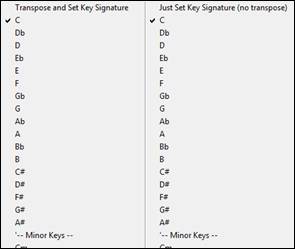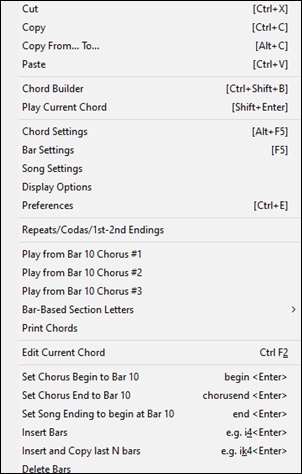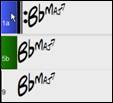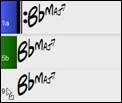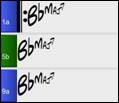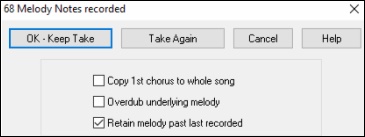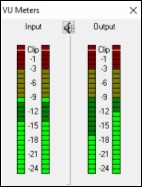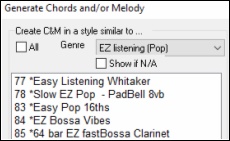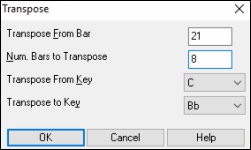Search Manual
Band-in-a-Box® 2021 for Windows® User's Guide
Chapter 6: Making Songs
Make Your Own Songs
It’s fun to play music with Band-in-a-Box, but it’s even more fun to make songs of your own. This section gives you step-by-step instructions from start to finish.
Clear the Chord Sheet
![]() Click on the [New] button if you need to blank the Chord Sheet.
Click on the [New] button if you need to blank the Chord Sheet.
Name the Song
Enter the title of the song by clicking in the title area and typing in the name.

Choose a Key
You can use the special operators “tk” and “tr” to set or transpose a key signature.
Typing tkc plus the Enter key will set the key of the song to C. Typing tkbb sets it to Bb. Note that this sets the key signature but does not transpose the song.
The “tr” operator sets the key signature and transposes the song. Typing trf and pressing Enter would transpose the song to the key of F, typing trab would transpose the song to Ab.
|
Another way to set a key signature is to click on the [Key] button and choose the key of your song from the lists of all major and minor keys. If you select from the “Transpose and Set Key Signature” column the song will be transposed to the new key signature you choose. |
|
If you select from the “Just Set Key Signature (no transpose)” column, the key signature will be changed but the song will not be transposed. You can have multiple keys in a song by changing the key signature in the Edit Settings for bar dialog (F5 function key). The new key signature is shown on notation. |
Setting the tempo
|
The tempo is displayed next to the key signature. You can quickly enter a specific tempo for the song by typing the letter “t” together with the tempo and pressing the Enter key. For example, type t140 and Enter to set the tempo of the song to 140. |
Click on the tempo box (hot key is Ctrl+Alt+T, or menu item Edit | Tempo | Set Tempo…), and a dialog will open up allowing you to type in a tempo.
When choosing File | New the tempo will be set to the best tempo for the current style. Click the mouse on the arrow buttons to adjust the tempo up or down.
- LEFT mouse click to change by 5 beats per minute at a time.
- RIGHT mouse click to change by 1 beat per minute at a time.
Setting the Relative Tempo
This button allows you to quickly set the relative tempo. Click the button and choose a percentage or use the Custom Tempo % menu item to set any value between 1% and 800%. 1% would be 1/100 of the original tempo and 800% would be 8 times the original tempo. Hot keys are available: Ctrl - (minus key) for half speed and Ctrl = for normal speed. |
Tap the Tempo
Not sure of the tempo for your song? Tap it in real time on either the minus [-] key or the equals [=] key on your computer keyboard. Four taps on the minus key sets the tempo, four taps on the equals key sets the tempo and starts the song playing. As you tap more than 4 times, the accuracy will improve (through averaging) and you can continue to tap until the target tempo has been reached. For example, in a 4/4/ style, once you tap 4 times a tempo will be set. But you can keep tapping and the tempo will change every beat, based on the average tempo that you have typed. You can also click the mouse on the on-screen [-] and [=] buttons to the right of the tempo box. |
“Framing” the Song
Framing a song designates the first and last bars of each chorus and the number of choruses Band-in-a-Box will play before playing the standard 2-bar ending.
You can type special words to set the beginning and end of the chorus, and the end of the song.
begin + Enter |
sets the beginning of the chorus to the current bar |
chorusend + Enter |
sets the end of the chorus to the current bar |
end + Enter |
sets the end of the song to the current bar |
Another option is to right-click a bar in the Chord Sheet to set it as the beginning or end of the chorus or the end of the song from the settings in the context menu.

For this song, bar one is the first bar of the chorus and bar 32 is the last bar of the chorus. The chorus will play three times, jumping to the two-bar ending the third time through. |
|
With the checkbox on the [Loop] button enabled the entire song will keep repeating until stopped. (This is a different feature from “LoopSection,” which loops the selected section of the song.) |
|
The “FakeSheet” checkbox is for a fake sheet style of Chord Sheet display with 1st and 2nd endings and repeats. |
Song Settings
|
The [Song Settings] button opens the Song Settings dialog for additional settings such as endings, tags, style variations, pushes, rests, and chord embellishments to make your song interesting and varied. |
You can also use the Ctrl+N keys or the Edit | Song Form | Settings (for This Song) menu command to open this dialog.
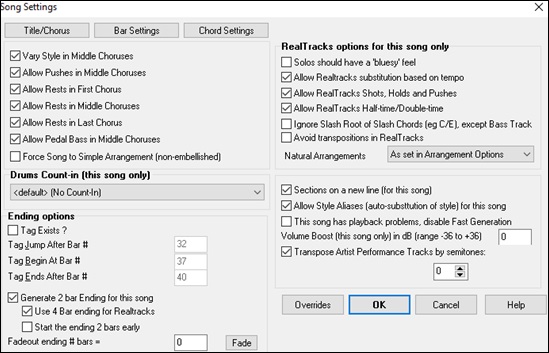
Vary Style in Middle Choruses: If set to “Yes,” the song will play in substyle “b” throughout the Middle Choruses. The Middle Choruses are considered all choruses except the first and last ones. For example, in the Jazz Swing Style, since the “b” substyle is Swing, all of the middle choruses will have swing bass, whereas the “a” substyle is playing half notes on the bass. If set to “No” the middle choruses will play A and B substyles exactly as they appear in the song as outlined by the part markers.
Allow Pushes in Middle Choruses: This is most frequently used if there are pushes in a song (indicated by the “^” symbol), but you don’t want these pushes to play in the middle choruses. Simply set the checkbox to “No” (disabled) and the pushes will be ignored in the middle choruses. This is to allow for uninterrupted soloing choruses.
Allow Rests in First/Middle/Last Chorus: These parameters allow you to decide which choruses will play any rests that are present in a song (indicated by the “.” symbol). For example, you may have put rests into a song but don’t want the rests to play in the middle choruses, since you are using them for soloing: simply set the ALLOW RESTS IN MIDDLE CHORUSES checkbox to “No” (off).
Allow Pedal Bass in Middle Choruses: This determines whether Pedal Bass effect will be allowed in middle choruses.
Force Song to Simple Arrangement (non-embellished): You can set the whole song to use “Simpler” RealTracks with this setting, as long as the RealTracks you are using have the simple option available. This is shown by a “y” in the RealTracks Picker’s “Simpler Available” column. The “Simpler” RealTracks play a less busy, less embellished arrangement.
Drums Count-in (this song only): You can select the count-in option for this song.
Ending Options: A tag (also referred to as a coda) is a group of bars that are played in the very last chorus of a song. If you select the “Tag Exists?” check box then the tag will play during the last chorus of the song. After the bar you specify as the “Tag Jump After Bar #” the song jumps to the “Tag Begin At Bar #” and plays through the “Tag Ends After Bar #” and then plays a 2 bar ending as usual.
Band-in-a-Box will optionally create a 2-bar ending for your song, the standard ending is 2 bars appended to the end of the song. The “Use 4 Bar ending for RealTracks” option allows extra time for the natural decay of the instruments. The “Start the ending 2 bars early” option gives you an alternative to end the song on the last bar of the song. Band-in-a-Box will still play an ending on the chord that you specify, and the ending will occur as a 2-bar phrase beginning 2 bars before the end of the form. This results in more natural endings for many songs.
Song endings can be turned off for all songs, or on a song by song basis. For example, you might want to have your own custom ending that ends the song on the 3rd beat of a bar by playing a shot. To turn the song ending off for a “single song,” set the “Generate 2 bar Ending for this song” checkbox to off (cleared). To turn song endings off for “all songs,” choose Options | Preferences and press the [Arrange] button to open the Arrangement Options dialog. Then, set the “Allow any Endings” checkbox to off (cleared).
You can quickly choose a fadeout ending, just press the [Fade] button, and Band- in-a-Box will fadeout the last “x” bars of the song (you can specify how many bars). Or customize the fadeout with precise values for each bar.
RealTracks options for this song only set the RealTracks options for the song without changing the global RealTracks settings.
Solos should have a ‘bluesy’ feel: When set, any soloist or RealTracks background soloist, will treat any major triad (C, F, etc.) like a dominant seventh (C7, F7) and use flatted 7th for soloing.
Allow RealTracks substitutions based on tempo: When set, the program will find the best RealTracks to use at the current tempo. For example, it might substitute an acoustic bass recorded at a higher tempo, closer to the tempo of your song. The RealTracks name will appear on the main screen with a tilde (~) to indicate the substitution.
Allow RealTracks Shots, Holds and Pushes: When set (recommended), Band-in-a-Box will create realistic shots, holds, and pushes in your song. If unchecked, Band-in-a-Box will simulate a shot. Not all styles have these available. Check the RealTracks\Library\Holds folder and the RealTracks Picker’s “Holds” column listing the set number.
Allow RealTracks Half-time/Double-time: When set, this song will allow RealTracks to play at half time (twice the usual tempo) or double time (half the usual tempo). This allows you, for example in a ballad at a tempo of 70, to add a RealTracks Sax solo with a tempo of 140 and play it as a double time, which will match the ballad tempo of 70.
Ignore Slash Root of Slash Chords (eg C/E) except Bass Track: If this is set, the RealTracks other than the Bass track will not play the slash root of chords. For example, the RealTracks will play C instead of C/E.
Avoid transpositions in RealTracks: If this is set, RealTracks will try not to transpose. This will result in better quality, but less variety in the arrangement.
Natural Arrangements: If you give a pro musician a complicated chord progression with fancy extensions like C7b9b13 or Gm11, the musician may reinterpret these rather than playing them exactly as written. This can achieve a much better sounding arrangement because the musician has freedom to choose from similar chord extensions. You can get Band-in-a-Box to do the same thing with this option for all tracks in the current song. (Note: To set this feature for all tracks in all songs, use the option in the Arrangement Options dialog. To set this for specific track(s) in the current song, right-click on the track radio button, go to Track Settings | Set Natural Arrangement, and select an option.)
Sections on a new line (for this song) is an option to enable/disable the section paragraphs feature for this particular song.
Allow Style Aliases (auto-substitution of style) for this song: If this is set, and Auto-replace MIDI styles with RealTracks styles when songs loaded is checked on the RealTracks toolbar menu, then auto-substitution with a RealStyle is allowed.
This song has playback problems, disable Fast Generation: On slower computers, songs with lots of RealTracks might have playback problems (stuttering). If so, you can use this setting to disable Fast Generation for this song. You can turn Fast Generation off for all songs in the RealTracks Settings dialog by unchecking the setting “Speed up generation of RealTracks (disable on slow machines).”
Volume Boost (this song only) in dB: The volume of any particular song can be boosted or cut by typing in the number of decibels. A change of 6dB is about the same as moving a MIDI volume control by a value of 32.
Transpose Artist Performance Tracks by semitones: If this is enabled, any Artist Performance tracks will be transposed (pitch stretched) by the amount entered here. The value is set automatically when you transpose your song, but you can adjust it here.
Chord Entry
Entering Chords from MIDI Keyboard
You can also enter chords from an external MIDI keyboard using the Window | MIDI chord detection… feature. Play the chord on the keyboard, then press Ctrl+Enter to insert the chord into the Chord Sheet on the first beat of the current chord cell, i.e., beat 1 or beat 3 of the bar. Use Ctrl+Shift+Enter to insert the chord on the next beat, i.e., beat 2 or beat 4 of the bar.
Another method allows you to choose alternate chords. Select the Window | MIDI Chord Detection | MIDI Chord Detection menu item to open the dialog.

When you play chords, Band-in-a-Box shows you the chord name and suggests alternates that you can choose from. Typing Ctrl+Enter enters the first selection and advances the highlight cell by ½ bar. To place an alternate chord in the Chord Sheet, click on the [Enter] button beside the chord you want.
Import Chord from Audio File - Audio Chord Wizard
You can import chords from an audio file using the Audio Chord Wizard.
|
This feature analyzes a WAV, WMA, MP3, WMV, or CDA audio file and imports it to Band-in-a-Box. The Audio Chord Wizard is fully described in the Working with Audio chapter. It works out the tempo, bar lines, and chord changes so you can easily make your favorite files into Band-in-a-Box songs. |
Import Chords from MIDI File - MIDI Chord Wizard
You can import chords from a MIDI file. To do this, first blank the Chord Sheet by choosing File | New. Then select the menu item File | Import | Import Chords from MIDI file to launch the Interpret Chords from MIDI file dialog. Press the [Open (Change)…] button to select the MIDI file that you’d like to import. Once you’ve selected the file, you can press the [INTERPRET CHORDS NOW] button. When you do that, the chords will be interpreted from the MIDI file, and written onto the Chord Sheet.
Importing a Band-in-a-Box Song
Easily import part or all of an existing Band-in-a-Box song to your current song, with options to specify source and destination range, type of information to import (chords, melody, lyrics, etc.) and more. Choose File | Import | Import MGU Song.
In the Import Band-in-a-Box Song dialog, choose the range that you want to import (Import from Bar and # of bars), and the destination bar (Import to Bar). You can also choose which information to import, and the insert mode (Insert/Overwrite).
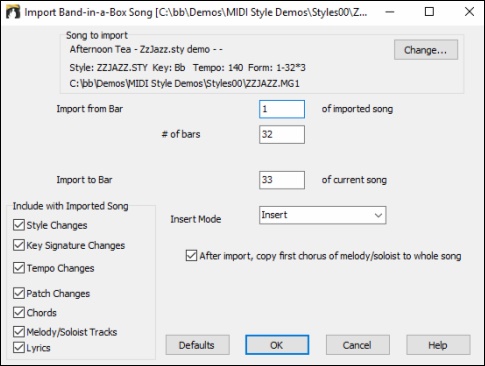
Computer Keyboard Entry
- The most common way of entering the chords for a song in Band-in-a-Box is by typing them in from the computer keyboard. Up to 4 chords per bar may be entered.
- Chords are commonly typed-in using standard chord symbols (like C or Fm7 or Bb7 or Bb13#9/E), but you can enter them in any of the supported chord symbol display formats - Roman Numerals, Nashville Notation, Solfeggio, and Fixed Do.
- To start typing in chords:
- Go to the top (Bar 1) of the Chord Sheet. The Home key will go directly there.
- Blank the Chord Sheet (if necessary) by clicking on the [New] button.
|
This is the chord highlight cell. Chords will be entered wherever this is placed. You may move this around by cursor arrow keys, the Enter key, or a mouse pointer click. |
The chord highlight bar moves 2 beats at a time (½ a bar). When you have the chord highlight cell over the area that you want to enter a chord, you simply type the name of
the chord you would like to see there.
For example, type c6 to get the C6 chord. Note that you should never have to use the Shift key, as Band-in-a-Box will sort this out for you.
- Use b for a flat, e.g. Ab7.
- Use 3 for a sharp #, e.g. for F#7 type f37.
- Use / for slash chords with alternate roots, e.g. C7/E (C7 w/E bass). A chord like Gm7b5/Db will display correctly using a Db instead of a Gm7b5/C#, since Band-in-a-Box bases it on a Gm scale.
- Use a comma to separate the ½ bar, enabling you to enter 2 chords in a cell. In the example below, we would type Ab9,G9 to get the 2 chords in the cell on beat 3 and 4 of bar 2.

- The sequence of keystrokes to enter all these chords above would be:
- HOME c6>am7>dm7>ab9,g9>c6/e>>a739
![]() A setting in the Display Options (Options | Preferences | [Display]) for “11th chords” allows display of ‘9sus’ chords as ‘11’ (e.g., Bb11 instead of Bb9sus). This only affects how the chord is displayed, not how it is stored, and you can type either C11 or C9sus to enter the same chord.
A setting in the Display Options (Options | Preferences | [Display]) for “11th chords” allows display of ‘9sus’ chords as ‘11’ (e.g., Bb11 instead of Bb9sus). This only affects how the chord is displayed, not how it is stored, and you can type either C11 or C9sus to enter the same chord.
|
The “Display ‘2’ as ‘sus2’” and “Display ‘sus’ as ‘sus4’” settings in the Display Options dialog will show suspended chords more explicitly: ‘sus’ implies ‘sus4,’ and ‘2’ implies ‘sus2,’ but you might want to see the full extension name. |
|
Right-click on a chord, and a menu allows you to make edits to the chords and other song settings. You can cut, copy, and paste chords in the Chord Sheet. Use the Chord Builder to try different types of chords or play the current chord to hear how it sounds. Chord Settings include pushes, rests, shots, holds, and pedal bass.
|
Support for other chord display types
You can enter or display chords in Roman Numeral notation, Nashville notation, Solfeggio, or Fixed Do notation.
For example, the chord Gm7 in the key of F would be displayed as IIm7 in Roman Numeral Notation, 2m7 in Nashville Notation, and Rem7 in Solfeggio.
|
In Italy and other parts of Europe, chords like C7 are always referred to by the Solfeggio name (“Do 7” for C7) regardless of the key signature. These systems are very useful for learning or analyzing tunes, since they are independent of the key signature. |
You can take an existing song, and print it out in Roman numeral notation, so you can study the chord progression. You can also type a chord in these systems, like “4” which will enter the 4 chord in the current key.
![]() Click on the [Chord Display] toolbar button and Choose type of Chord Display from the menu. A yellow message box will confirm your selection.
Click on the [Chord Display] toolbar button and Choose type of Chord Display from the menu. A yellow message box will confirm your selection.

![]()
The Roman numeral and other nonstandard displays use superscript for the chord display when in the Notation window (or when printing out). Therefore, the alternative chord symbol displays are best viewed in the Notation window.
There is an option to display the non-standard chord above the standard chord on the Chord Sheet.
|
Press the [Chord Display] button, go to Layers | Additional Chord Display, and choose from the list of four options. |

![]()
Preview Chords
This feature allows you to hear chords as you type them in. After you type a chord name onto the Chord Sheet (or the Notation window), press the Shift+Enter keys. This enters the chord onto the Chord Sheet and then plays the chord for you, using the MIDI patches on the Piano and Bass tracks. You can also listen to a chord that has already been entered, by just pressing the Shift+Enter keys after moving the highlight cell to the bar with the chord you want to hear. If there is no chord entered at a bar, you will hear the last chord that was entered.
Chord Builder
You can right-click on any chord to instantly hear how it sounds or use the Chord Builder feature to audition different chords until you find the one that sounds best to you. In other words, you can enter chords “by ear” - without having to know the actual chord names or any music theory. This feature also illustrates the differences between various chord types.
|
Launch the Chord Builder by pressing the [Chord Builder] button, or right-clicking on the Chord Sheet and selecting the menu option Chord Builder, or by choosing the Window | Chord Builder menu option. |
The Chord Builder is designed so it fits entirely above the Chord Sheet. This means that it can be left open as you work entering chords into Band-in-a-Box. Remember that you can also play chords in from the MIDI keyboard by pressing Ctrl+Enter after you’ve played a chord.
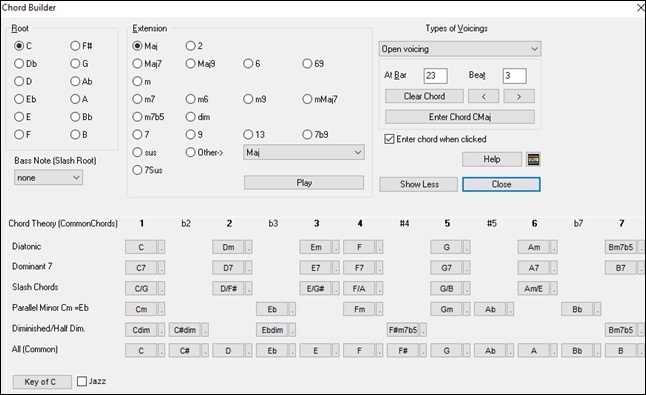
You can click on the root of the chord in the “Root” group, and the “Extension” (Maj7 etc.), and also an alternate “Slash-Note” root. For example, to make the chord F9/A, you would click on the “F” root, the “9” extension, and the Slash Root of /A. As you click on them, you will hear the bass note played on the Bass part, and the extension played on the Piano track.
Chord Theory Section
This section displays and suggests chords that are most popular in the current key.

The top row is diatonic chords. Other rows add additional chords that are part of the key, such as dominant 7th approach, slash chords, parallel minor, diminished, and more. This allows you to quickly enter chords by clicking on the most common chords in the key. For example, if you stick to the top row (diatonic), the chord progression you enter will be a typical song progression. Choosing from other rows will add variation and color to the progression. This is a fun, interactive way to enter and explore chord progressions, and learn music chord theory at the same time.
You can enable the “Jazz” checkbox to show jazz chords (e.g. sevenths like Maj7) instead of pop chords (e.g. triads like C). The top row has the most common chords in the key of F, which are the diatonic chords.
F |
Gm |
Am |
Bb |
C |
Dm |
Em7b5 |
(in pop mode) |
FMaj7 |
Gm7 |
Am7 |
BbMaj7 |
C7 |
Dm7 |
Em7b5 |
(in jazz mode) |
So, you can just click on chords on this row to enter your chord progression using the most popular chords. Lower rows have additional chords in the key of F, like G7, A7, etc.
Diatonic: These are the diatonic chords, made up only of notes in the key. They are the most common chords used in the key, with the 1, 4, and 5 chords being the most common.
Dominant 7: These chords are considered to be in the key when they resolve up a 4th to a scale tone. For example, A7 resolves to D, which is a scale tone in the key of C.
Slash Chords: The diatonic chords are also commonly used with different chord tones as the bass note. They are called slash chords, like C/E.
Parallel Minor: For a major key like C, the chords from the Cm key are also used commonly.
Diminished/Half Dim.: The most common diminished chord used is the 1 diminished family [Cdim7, Ebdim7, F#dim7] in the key of C. Half-diminished chords (e.g. #4m7b5 [F#m7b5] and 7m7b5 [Bm7b5]) are used as 2-5-1 leading to minor diatonic chords.
All (Common): This row lists all commonly used chords with the root in the key.
Clicking on the small button on each row will list more suggestions.

If you are happy with the sound of the chord, you can press the [Enter Chord] button to enter the chord at the bar and beat specified. If you would like the chord to be inserted automatically when you click on the note/extension names, select the “Enter chord when clicked” option. This will advance the Bar/Beat position. You can change the Bar/Beat settings to move to a different bar. The [<] & [>] buttons move 1 beat on a right-click, and 2 beats on a left-click.
Delete Chords
The chords at the current location of the highlight cell are cleared by the Delete key, the Windows® “Cut” command, or by typing a comma and pressing Enter.
Deletion of chords over a range of bars can be done by selecting the range and pressing the Delete key on your computer keyboard. No confirmation dialog is required.
Enter Breaks (Rests, Shots, and Held Chords)
Breaks are points in a song when one or more of the instruments rests, plays a shot, or holds a chord.
- Rests specify any, some, or all instruments to rest at any bar. For example, you could rest all instruments except the bass for the first 4 bars, and then add the piano for 4 bars, and then add the entire band for the rest of the song. You may optionally disable the rests in the middle or final choruses (e.g., where you would likely have a solo, and rests may not be appropriate).
- Shots specify certain instruments play a “shot,” where the chord is played and then a rest follows. For example, the song “Rock Around the Clock” has a shot on beat 1 followed by a rest for 2 bars. The duration of “shots” is 60 ticks per beat.
- Held chords specify that certain instruments hold a chord sustained for a certain number of bars. For example, you can have the bass and piano hold a chord sustained while the drums continue to play a pattern.
A chord can be specified as a REST by adding a period after the chord.
C. indicates a C chord that is a REST.
A chord can be specified as a Shot by adding two periods after the chords.
C.. indicates a C chord that is a SHOT.
A chord can be specified as a Held Chord by adding three periods after the chords.
C... indicates a C chord that is a HELD CHORD.
Selecting BREAKS for different instruments.
You can specify that some instruments not be affected by the rhythm break.
The coded names for the instruments are:
B for Bass, D for Drums, P for Piano, G for Guitar, and S for Strings.
To type a rest for all instruments on a C chord type C.
To exempt instruments, add their letters following the break. For example,
C.bd will put a rest on all instruments EXCEPT the bass and drums.
To indicate a held chord for all instruments except the piano, type C...p

Breaks can also be set in the Chord Options dialog.
Chord Options
|
Chord options include rests, pushes, and pedal bass. The Chord Options dialog opens with the C7 toolbar button, or from the right-click contextual menu in the Chord Sheet. |
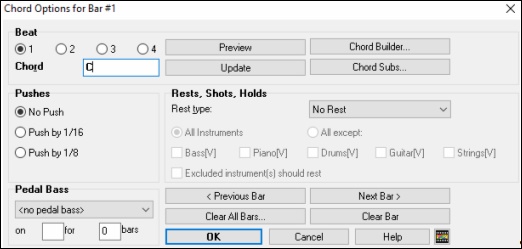
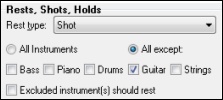
When a “shot” or a “held” chord is assigned, the instruments that are excluded from the shot/held chord play normally.
There is an additional option for those excluded instruments to stay silent. To set this, select a shot or held chord and enable the “Excluded instrument(s) should rest” option. This option gives you the ability to rest some instruments while others play the shot or held chord.
Other settings for how chords play are in the Edit menu. You can choose Edit | Song Form | Settings (for This Song) to open the Song Settings dialog and set the rests (breaks) to happen only in the first, middle, or last choruses. There are also settings to allow pushes, pedal bass, and chord embellishment.
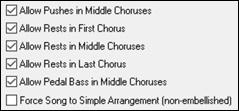
“Pushes” (also called anticipations) are chords that are played before the beat. For example, in Jazz Swing music, the piano player often “pushes” a chord change by playing the chord an eighth note before the beat. To execute a “push,” you can use either keystrokes or open the Chord Options dialog by right mouse clicking on a given chord.
To use keystrokes:
Type the caret symbol [^] before the chord. The caret symbol is located above the numeral 6 on your computer keyboard.
Type a single caret to get a chord an eighth note before the beat, e.g., ^C7
Type a double caret to get a chord a sixteenth note before the beat, e.g., ^^C7
In Jazz styles (and other triplet feels), the chord will be pushed by a triplet, regardless of whether there is a single or double caret (^^).
Velocity Boosts for Pushes, Shots, and Held Chords

You can set the amount of velocity boost, so that the effect won’t be too loud. In the Preferences dialog (Options | Preferences) click on the [Arrange] button to open the Arrangement Options dialog. Then type in the amount of velocity boost for pushes, shots, and holds.
The style can override the velocity for the pushes, and drum velocity for shots, held chords, and pushes is also set in the StyleMaker.
Copy Breaks
With the menu selection Edit | Copy Special | Copy Rests you can copy the attributes (rests/shots/holds) of a chord over a range of other chords.
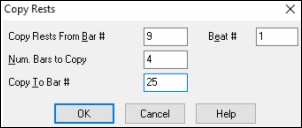
Copy Breaks by Shortcuts
When entering chords on the Chord Sheet, there are shortcuts available for entering rests over a range of bars.
Type h4 on a chord, and this will copy the rest/shot/hold on the first beat of the cell for 4 bars.
Type ,h4 on a chord, and this will copy the rest/shot/hold on the second beat of the cell for 4 bars.
Type h on a chord, and this will copy the rest/shot/hold/ until the next part marker.
Type a chord with a rest/shot/hold followed by a number (N), and this will do this for the next N bars.
e.g. C7...4 will enter held chords for 4 bars
Gm7...bd5 will enter held chords (bd=except bass and drums) for 5 bars
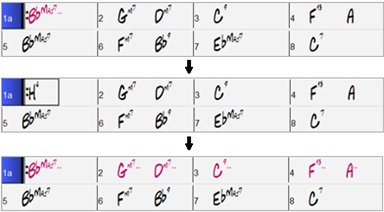
Erase Chords From.. To..
To erase bars with additional control for erasing the Melody, Soloist, and/or Lyrics, choose Edit | Erase From.. To.. to launch the Erase Chords and / or melody dialog.
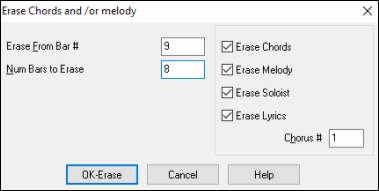
With this dialog, you have complete control over erasing a number of bars of chords and/or the Melody, Soloist, and Lyrics. If you’re erasing the Melody, Soloist, or Lyrics you need to specify which chorus you wish to erase.
Insert/Delete Bars
Choose Edit | Insert Bars, and the program will ask you to type in the number of bars you wish to insert.
Choose Edit | Delete Bars, and the program will ask you to type in the number of bars you wish to delete.
Copy and Paste a Section of Chords
Copying a section of chords is done in the same manner as copying text in a Windows® word processor (read on if you are unfamiliar with how this is done). There are also similar “keyboard shortcuts” for these operations as listed in Keystroke Commands – Hot Keys section of this guide.
Copying Chords to the Windows® Clipboard
Select the region to copy. Place the mouse cursor at the bar to begin the selection. Then, holding down the left mouse button, drag the mouse over the region. As you do this you will see that the region will be inverted (i.e. looks dark). When you have selected the desired region of chords to copy, release the mouse button.
Copy the selected region to the clipboard. Press Ctrl+C or choose Copy from the Edit Menu.
Pasting Chords from the Windows® Clipboard
- Assuming you have already copied some chords to the clipboard (see previous topic), you are then ready to paste the copied chords into another part of your Chord Sheet.
- Move the highlight cell to the bar to begin the paste of chords.
- Press Ctrl+V or choose Paste from the Edit Menu.
Copy and Paste Section of Chords by Drag-and-Drop
Copying of sections or selections can be done using drag-and-drop, to drag regions around the Chord Sheet to quickly rearrange your song. Hold down the Ctrl key for finer control about insert/overwrite etc.
For example, if you have an 8-bar section at bar 9: To copy it to bar 23 and insert the 8 bars at that location, drag the bar # and drop it at bar 23. To copy it to bar 23 and OVERWRITE the 8 bars at that location, hold down the Ctrl key and drag the bar # and drop it at bar 23. In the dialog that appears, just press OK. |
Copy Chords and/or Melody
Another way to copy chords is to launch the Copy Chords and/or Melody dialog by pressing Alt+C.
This allows you to copy chords/ melody/ soloist/ lyrics for a range of bars by entering the From and To locations and the number of bars to copy. Select the checkboxes for the items you want to include in the copy.
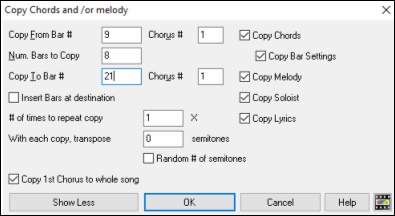
Insert Bars at destination If selected prior to the Copy bars will be inserted onto the Chord Sheet at the destination chosen.
# of times to repeat copy If set to more than one, multiple copies will be made, optionally with transpositions on each copy. These are all applied to the first chorus only.
With each copy, transpose ___ semitones If more than one copy is selected, this will transpose the song with each copy. This is most useful when wanting to learn a short phrase (“riff”) in different keys or modulating a section of a song.
Random # of semitones This will transpose the copy a random transposition and would be useful for advanced students who are trying to master a riff or phrase in all keys.
Copy 1st Chorus to whole song If set, this will apply any of the copying commands in this dialog to all choruses of the song, not just chorus #1.
The [Close] button does not copy chords and/or melody but preserves the current settings in the dialog.
”K” Quick Copy Method
By simply typing “K” at a bar followed by the Enter key, you can instantly copy the last 8 bars to the current position. By adding additional keys in the K command, you can customize this shortcut (e.g. typing K 12, 3 would copy from bar 3 for 12 bars to current position.) The current position is advanced to the bar beyond the copy. This speeds up song entry!
For example, if you’re entering a song that has a repeating section of chords for 8 bars, type in the first 8 bars of chords, and then move to bar 9 and then type: k, Enter.
The last 8 bars will be copied to bar 9-16, and the cursor will be moved to bar 17, so you’re ready to continue with the tune. If you get to bar 25 and would like the chords from 1-8 to be copied to 25-32, type k,1 and this will copy 8 bars from bar 1 to bar 25.
The chords always get copied. The Melody, Soloist, and Lyrics also get copied if these items are set in the Copy Chords and/or melody dialog
Copy/Paste Chords as Simple Text
Chords from a Band-in-a-Box song
Chords can be copied as a simple text format and be pasted into another song in Band-in-a-Box or a text file in a program like Notepad.
Select the chords on the Chord Sheet, and press the standard Ctrl+C keys to copy them. You can then press Ctrl+V in another song or a text file to paste them.
By default, part markers as well as rests, shots, holds, and pushes are included in text, but you can change this with the options in the Song(s) to Text (clipboard or .txt file) dialog. This dialog also allows you to select the items that will be included when you copy the whole song. Using this dialog, you can also copy all songs in a specific folder to the clipboard or save them as text file(s). The dialog can be accessed with the Edit | Copy Special | Copy Song(s) to Text on clipboard or file(s) menu item.
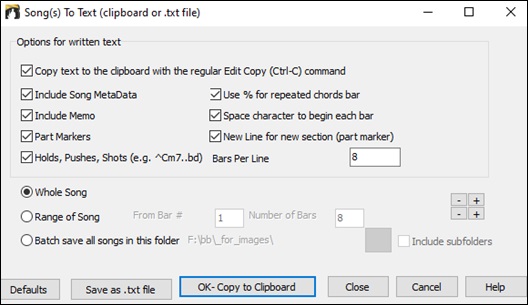
Copy text to the clipboard with the regular Edit Copy (Ctrl-C) command: This has to be enabled in order to copy chords with the standard Ctrl+C keys.
Include Song MetaData: This option applies when you copy the whole song. If this is checked, the song metadata (title, key, tempo, form, style, etc.) will be included.
Include Memo: This option also applies when you copy the whole song.
Part Markers: By default, part markers are copied, but you choose not to copy them.
Holds, Pushes, Shots: By default, rests, shots, holds, and pushes entered in chords are copied, but if you don’t want them, uncheck this option.
Use % for repeated chords bar: If this is enabled, a % sign will be used for a blank bar.
Space character to begin each bar: If this is enabled, a space will be added at the beginning of each bar.
New Line for new section (part marker): If this is enabled, every section (part marker) will start a new line.
Bars per line: You can set the number of bars of chords to write per line.
Whole Song: If you select this mode, you can press [OK - Copy to Clipboard] to copy the whole song (chords and additional information selected) or [Save as .txt file] to save it as a text file.
Range of Song: If you select this mode, you can press [OK - Copy to Clipboard] to copy the chords in the selected range or [Save as .txt file] to save them as a text file.
Batch save all songs in this folder: With this mode, you can copy or save all songs in a specific folder. Press the folder icon to select the folder, and choose the option to include subfolders of that folder. Also select the destination with the Batch Save As option. You can copy all songs to the clipboard, save them as individual text files in the same folder, save them as individual text files in another folder, or save them as a single text file. Then, press [OK -Batch Save TXT] to copy or save the songs.
The [Defaults] button resets all options to default settings. The [Close] button closes the dialog, saving the settings but not copying anything.
Chords from a text file
You can copy chords in a text file and paste them into a Band-in-a-Box song. Type chords in a text file using a vertical line for a bar line. If you want a blank bar, leave a space or type a % sign between vertical lines. For example, you can type | D | G7 | | F | or | D | G7 | % | F |. You can use shortcuts and non-standard chord display (e.g., | 1j | 2h | 53 |). To add breaks (rests/shots/holds), type period(s) after the chord. To add pushes, enter caret(s) before the chord. If you want a part marker, type a or b and a parenthesis after a vertical line. You can type as many bars as you like on each line.
You can even enter a whole song in a text file. The easiest way is to use the text file that you pasted the whole song into. Some of the information pasted into that text file cannot be pasted back into Band-in-a-Box because they are not applicable for a new song. For example, “Song Summary” is no applicable because this is automatically generated in the song and cannot be edited by a user. However, it will not cause problems if you leave them in the text file. You can include a title, a key, a tempo, a form, a style file name, and a memo.
When you are ready, press Ctrl+A to select all and Ctrl+C to copy. Then, in Band-in-a-Box, press Ctrl+Shift+V or go to menu Edit | Paste Special - from Clipboard text to Song(s). This will open the Paste text to Song(s) dialog.
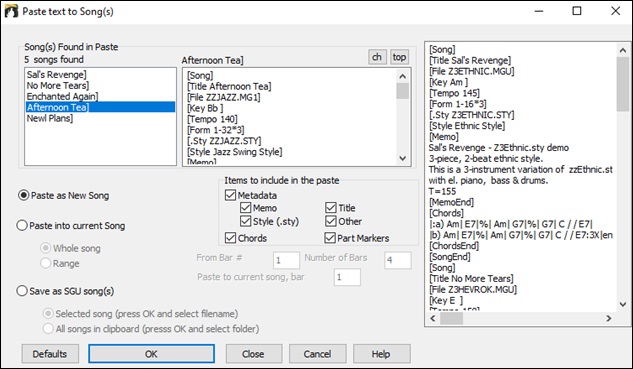
Song(s) Found in Paste: If you created multiple songs in the text file, you can select the song to paste.
Items to include in the paste: Check the items you want to include in the paste.
Paste as New Song: This mode will paste all the chords in the selected song into a new song
Paste into current Song: This mode will paste into the selected bar in the current song. You can select either the Whole song option to paste all chords in the song or the Range option to paste the chords in the selected range of the song.
Save as SGU song(s): This mode will save the selected song or all songs on the clipboard as new song(s). To save the selected song as a new song, select the Selected song option. Then, press OK, select a folder, and type a file name. To save all songs as new songs, select the All songs in clipboard option, press OK, and select a folder.
Reduce or Expand Chord Durations
Edit | Song Form | Reduce (durations of chords by 1/2) cuts chord durations by 50% (e.g., 4beats>>2beats, 2beats>>1beat, etc.).
Edit | Song Form | Expand (durations of chords by 2) doubles the durations of chords (e.g., 1beat>>2beats, 2beats>>4beats, etc.
Search/Replace Chords
![]()
![]()
![]() A Search/Replace Chords feature will search and replace chords, including support for asterisks (*) as wildcards. Search and Replace can be used with Roman numerals or numbers for chord names. So, you can replace the V chord with V7, or the 5m chord to 5m7.
A Search/Replace Chords feature will search and replace chords, including support for asterisks (*) as wildcards. Search and Replace can be used with Roman numerals or numbers for chord names. So, you can replace the V chord with V7, or the 5m chord to 5m7.
Since these are remembered between songs, this feature is useful if you are changing multiple songs.
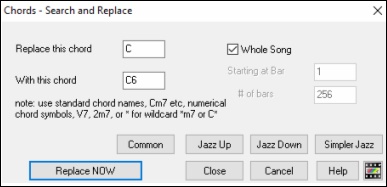
The [Simpler Jazz] option will simplify chords like C13#11#5 to simply C9.
Intro Bars – Auto Generate (or Remove)
 |
To generate an intro, press the [Song Form] toolbar button and select Generate Into from the pulldown menu. You can also go to the menu Edit | Song Form | Intro Bars… The Generate Chords for Intro dialog will then open. |
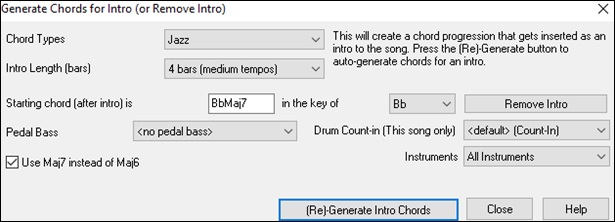
With a single press of a button you can auto-generate a 2, 4, or 8 bar intro for any song. The chords will be different each time, and you can keep trying as often as you like until you get the progression that you want. The intro generated will be an intelligent chord progression (i.e. appropriate for an intro) in the chosen style of music (Jazz/Pop). It can have optional pedal bass and will “lead” correctly to the first chord of the song. There is also an option to have the intro be played by the whole band, a specific track, or any combination of tracks.
The duration of the intro can be set to 2, 4, or 8 bars. You can also get a pedal bass figure inserted throughout the intro. Press the [Remove Intro] button to delete any intro present in your song.
‘Jazz Up’ the Chords
The Edit | Chords | ‘Jazz Up’ the chords menu command will “Jazz Up” the chords by changing chords like C and Cmaj to 7th and 6th chords. Song embellishment will be turned on for the song. Select the type of 7ths from the list box, and then click on the [OK – Jazz UP] button.
‘Jazz Down’ the Chords
The Edit | Chords | ‘Jazz Down’ the chords menu command “Jazz Down” the chords by changing chords with 7ths (e.g. C7) to triads (e.g. C) and 9ths and 13ths to 7th chords. Song embellishment is turned off. Press [OK – Jazz Down] to proceed.
Chord Substitution
Reharmonizing a song with the Chord Substitution Wizard is a fun and educational way to perform or practice a familiar song in a brand-new way. For example, if you had chords such as “Dm7 G7 Cmaj7,” a list of substitutions including the tritone substitution “Dm7 Db7b5 Cmaj7” would be offered to you for use in your song.
There are 2 ways to get chord substitutions
- Let Band-in-a-Box show you a list of possible substitutions to pick from yourselfby accessing Edit | Chords | Chord Substitution Dialog menu item.
- Let Band-in-a-Box pick them automatically by accessing Edit | Chords | Auto-Generate Chord Substitutions menu item.
Manual Chord Substitutions
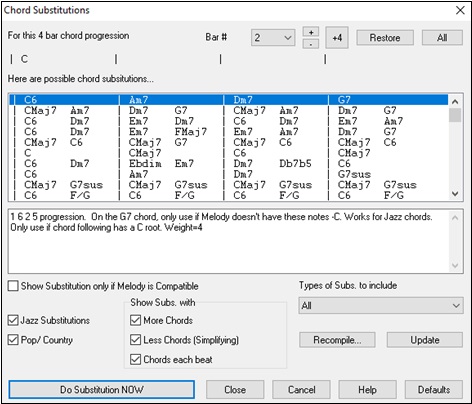
This dialog depends on what chords were present at the bar that was currently highlighted. This bar number is shown in the dialog and may be changed.
In the example shown, the chord was an F7 chord, so the substitutions shown are for an F7 chord. The substitutions shown may work for up to 4 bars, depending on the substitution. In the examples above, the substitutions work for 2 bars.
Jazz Substitutions / Pop/ ountry You can control what types of substitutions to see by using these checkboxes. Some substitutions include more chords than the original, and some simplify the progression, and these can be viewed using the checkboxes. You can elect to exclude substitutions that have a chord on each beat.
Types of Subs. to include This combo box will filter the substitutions to include only the best substitutions or all of them.
[Recompile] This button is only used if you have edited the chordsub.txt file to add your own substitutions. This recompiles the file and takes about 1 to 2 minutes.
[Do Substitution NOW] Press this button once you see a substitution that you like so that you can enter it onto the worksheet directly. Double-clicking on the substitution line will also accomplish the same. You can then move the current bar to the next part of the song that you need a substitution for and repeat the process.
You can UNDO the substitution by pressing the [Restore] button, or the [All] button to UNDO all substitutions.
Auto Chord Substitutions
You can quickly auto-generate substitutions for an entire song, or portion of a song using the auto-substitution dialog, which is accessed with the menu command Edit | Chords | Auto Generate Chord Substitutions.
For example, we can generate substitutions for the !Freddie.MGU song. Here is the original chord progression.

By using the auto-substitution dialog, we can generate substitutions for the whole song, and we get this result:

You can see that Band-in-a-Box chose the substitutions for about 70% of the chords in the song (that’s what we told it to do in the dialog). It began by replacing the F6 chord with an Fmaj7 Gm7 Abdim Am7 progression. Some of the substitutions chosen are even more advanced than that (replacing two bars of Bbmaj7 with Bb6 Ebmaj7 Dm7 Gm7 | Bbmaj7 Cm7 Dbdim Dm7 for example).
Here are the settings in the auto-substitution dialog that produced this result:
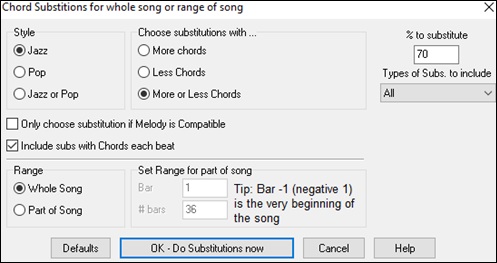
If you’d like Band-in-a-Box to only generate chords for a certain range of bars, you should highlight that range of bars in the Chord Sheet first, and then launch the dialog. The Range will then be set to “Part of Song” and the “Bar” and “# bars” settings will also be set. You can override these settings with manual settings, if necessary.
Reharmonist (Chords for a Melody)
Generate Chords for a Melody
Generate chords for a melody, or an improved chord progression for a melody, with the “Reharmonist” feature. This feature generates a chord progression in the chosen genre, based only on the melody.
The idea of the Reharmonist is to generate a completely new chord progression for a melody, in a genre that you choose (Jazz, Country, etc.). This ignores any existing chords in the song.
There are 2 separate windows for the Reharmonist feature.
- Reharmonize entire song with a new chord progression.
- or -
- See a list of possible reharmonizations for a given area of a song.
Generate a New Progression
To generate an entirely new chord progression for a complete song or a portion of a song, go to menu Edit | Chords | Auto-Generate Chord Reharmonization). You will then see the Select Re-Harmonist dialog.
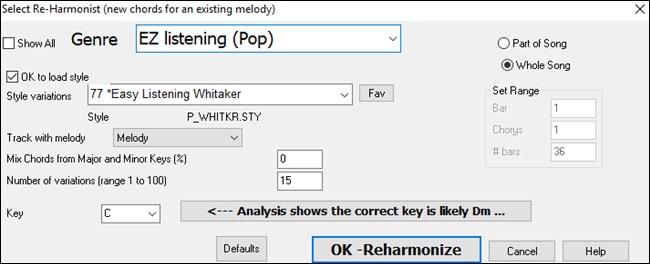
The first thing you should do is set the “Genre” for the reharmonization. For example, if you want “Jazz Swing” genre, choose that in the genre drop down. You will then get typical Jazz chords.

Verify that the key is correct. Band-in-a-Box analyzes the melody and gives its best guess as to the best key for the song. If it is different from the current key, Band-in-a-Box will suggest the new key, and you can press the button to set the key to the new key.
![]()
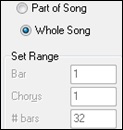 |
Set the region of the song that you want reharmonized. Usually this will be the “Whole Song.” |
Press [OK-Reharmonize]. You will now get a brand-new chord progression for the melody.
See a List of Possible Reharmonizations
Use the feature interactively by displaying a menu of possible chord progressions for a portion of the melody and audition them to choose the best one using the “Bar Reharmonist.” This allows you to hear some new chord progressions for existing melodies, or brand-new progressions for tunes without chords.
To do this, choose Edit | Chords | Chord Reharmonist Dialog (choose your own). This shows you the current bar in the song (for example, bar 7). It shows a list of suggested chord progressions for the current melody, based on the melody and genre that you choose.
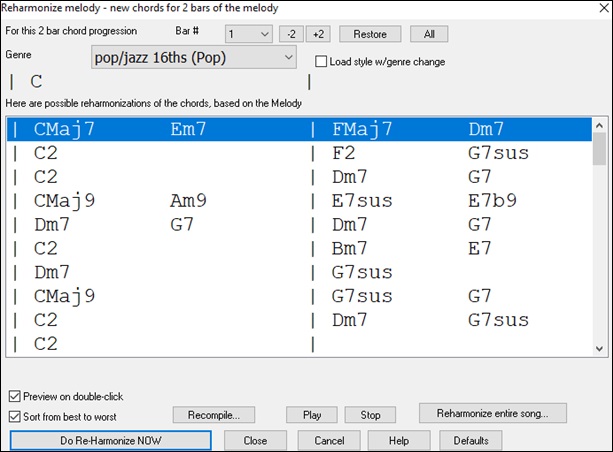
The progressions are sorted in alphabetical order, or from “best to worst” depending on the "Soft from best to worst" setting.
Choose a chord progression, and press [Do-Reharmonize NOW] and the program will insert that progression.
Rearrange Chords - Song Form Maker
The Song Form Maker allows you to define sections of a song (A, B, C etc.), and then rearrange the song by simply typing the form you want (e.g. AABABAACA). You can revisit the dialog to change the form at any time.
Press the [Song Form] button and select Song Form Dialog from the menu. You will then see the Song Form Maker dialog. |
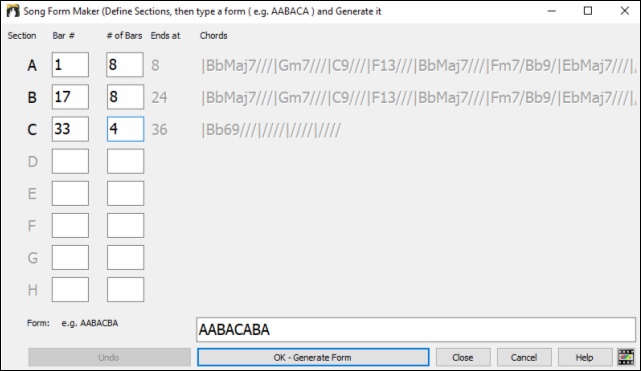
Then define your sections (e.g. A = bars 1 for 8 bars, B=start at bar 17, for 8 bars C=start at bar 25, for 4 bars). Then type the form that you want (AABACABA).
Select [OK-Generate Form] then exit the dialog. The form string and sections are saved with the song.
You can revisit this dialog to re-order the sections. Or change a chord in the “A” section of the Chord Sheet, and then use the Song Form Maker to propagate the changes through all of the “A” sections.
Use the [Undo] button to reverse your changes.
Uses for the Song Form Maker
- Enter a song by simply entering each section once, and then visit the Song Form Maker, typing the form that you want and generating it. Change the form without having to type in new chords, just redo the Form String (“AABACABA etc.)
- Change chords in each section by simply changing the chord in the main section, and then regenerate the form.
- Enter a melody once and copy it throughout the form by regenerating the form.
Part Markers and Substyles
Part Markers
![]()
Part Markers are placed on the Chord Sheet to indicate a new part of the song, to insert a substyle change, or to insert drum fills. They typically occur every 8 bars or so but may be placed at the beginning of any bar.
You can customize the display of the part markers in the Display Options dialog. For example, you can pick a color for each part marker, draw part marker borders, show each part marker on the new line, etc.

MultiStyles
Band-in-a-Box MultiStyles are styles that can have up to 24 substyles; original Band-in-a-Box styles had two substyles, “a” and “b.” Band-in-a-Box MultiStyles typically have four substyles, but may have up to twenty-four, selected by using part markers “a” through “x.”
You can easily make your own MultiStyles, either from scratch, or combining parts from existing styles to make a MultiStyle. For example, if you have 10 favorite Country styles, you can quickly make a single MultiStyle that has 20 substyles available within the same song.
You can store names for MultiStyle substyles with a description of each one.

|
The MultiStyle names are set in the StyleMaker Miscellaneous dialog. If the style is a MultiStyle, you can right-click on a bar number to see them. |

Changing Substyles
![]()
![]()
![]()
![]()
Each style has “a” and “b” substyles. Band-in-a-Box Multistyles also have “c” and “d” substyles and could have from “a” to “x” for a total of up to twenty-four.
Most of these MultiStyles that we’ve made have 4 substyles, conforming to the following pop song format.
|
Substyle “a” is usually used for the verse of a song. |
|
Substyle “b” is usually used for the “b-section” or the chorus, and for soloing in the middle choruses. |
|
Substyle “c” is usually used for the intro or for an opening verse or pre-verse. |
|
Substyle “d” is usually used for a break or interlude. |
You can see the MultiStyle markers on the Chord Sheet.

There is always a part marker at bar 1 so that Band-in-a-Box knows which substyle to begin with. The song continues to play in one substyle until it encounters a new part marker. The substyle will change automatically on second choruses when the “Vary Style in Middle Choruses” song setting is selected.
Placing Part Markers
- Move the highlight cell to the bar where you want to place the part market. Then press the P key on the computer keyboard. Repeatedly pressing P scrolls through all available part markers,
or - Position the mouse cursor directly over the bar line (or an existing part marker). Then, click the left mouse button. Repeat this procedure to scroll through the available options.
- To remove a part marker, keep pressing P or clicking the mouse until you reach the end of the available part markers and there is no marker on the bar number.
Copying Part Markers
You can drag a part marker to copy it to other bars.
|
|
|
|
|
Placing Drum Fills
A one bar drum fill will occur in the bar preceding a part marker. If you want a drum fill at bar 7 of a song, you insert a part marker on the bar after the bar with the drum fill (i.e. Bar 8). You can either retain the original substyle or change the substyle (a, b, c, d, etc.) when you place the part marker.
![]()
Section Paragraphs
When you’re reading a book, a new section begins on a new line, with space between. Band-in-a-Box does that for chords too. Whenever a new section occurs (a part marker), we start the new section on a new line and draw a grey line above to clearly mark the new section. You will see each section on a new line so that the form of the song is easier to see.
For example, if you have a song with a 7-bar section, followed by 8-bar sections, earlier versions of Band-in-a-Box wouldn’t start the other sections on a new line. The result was that it was hard to delineate the sections, as if an entire story was told within one paragraph.

With the Section Paragraphs feature, you will see each section on a new line so that the form of the lead sheet is easier to see. Sections can be as short as 2 bars.

The feature is configurable and optional with the “New line for every section” setting in the Display Options dialog (Options | Preferences [Display] button). You can also set the minimum number of bars that is required to start a new line with the “minimum section” setting. For example, if this is set to 8, then there won’t be a new line for the next part marker if that section has only 4 bars.
![]()
Applying Styles
There are many styles available for use with the Band-in-a-Box program. Styles refer to styles of music like Jazz Swing, Latin, Blues, Pop, Rock, or Country. You can pick a musical style either before or after you have entered the chords to a song. Once a style is loaded, the song will be played back using your chosen style. All style files have the .STY extension. In the Chord Sheet or the Notation window you can quick-load a style by typing only “style” followed by a style name, e.g., stylezzbossa<Enter> will load in zzbossa.sty.
When a requested style is not found, Band-in-a-Box makes an intelligent substitution.
![]()
This feature is available for every style that PG Music has made, and also can be customized by third-party or any users by making a text file (*.NA) with suggested alternative styles.
Load Previous Style, Load Next Style
This function, analogous to the Load Next Song function, loads in the previous (or next) style in alphabetical order of the file name. These functions are found in the Styles menu or use the hot keys Ctrl+Alt+Shift+F8 for the previous style and Alt+Shift+F8 for the next style.
Current Style Windo
The name of the current style is shown in the window below the song title.

There is a convenient “Load Song Demo” option for style demos. Click on the name of the style on the main screen, and the menu that displays will include the option to “Load Song Demo” for the current style.
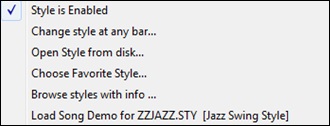
This menu also offers options for choosing a style for your song. Change style at any bar inserts a style change at the currently highlighted bar on the Chord Sheet. Open Style from disk is for selecting styles from file folders. Choose Favorite Style opens either a list of pre-selected favorites, or a list of recently played styles. Browse styles with info opens the StylePicker window, which has full style information.
Open Style with the [Style] Button
|
You can open a style using the [Style] button. This is a split button, with the top half being the default function, and the bottom half listing different methods to load a style and allows you to set the default. |
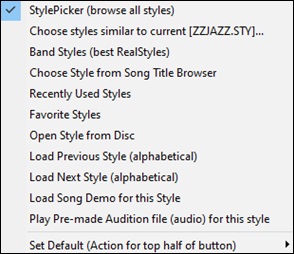
StylePicker Window
|
The StylePicker window is opened by pressing the [Style] button or the Ctrl+F9 keys. It lists all of the styles that are present in the C:\bb\Styles folder. The StylePicker window has a great filter feature for finding a perfect style for your song by selecting elements such as time signature, feel, or tempo or by simply typing in a familiar song title. |
You can browse styles by sorting columns or hear an “instant” preview of the style by double-clicking on the list. If style has both MIDI and RealDrums available, you can hear both, and choose which one you want. This makes it much faster to find the style that fits your song.
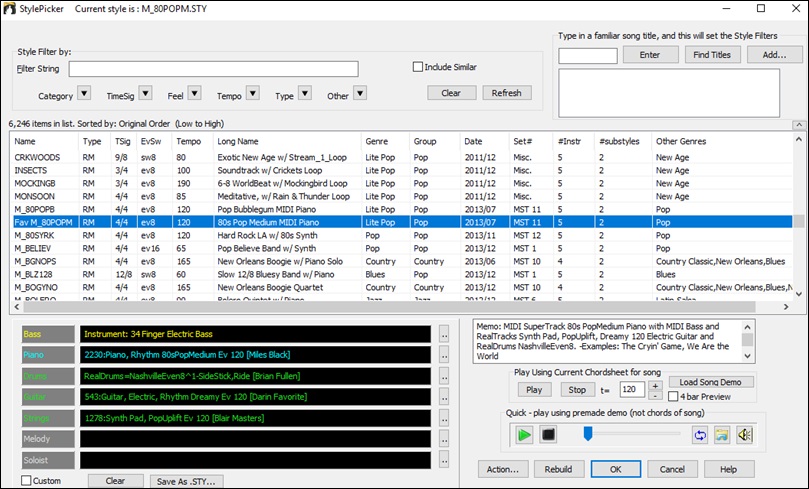
If the style list needs rebuild when you open the StylePicker, it tells you that in the progress bar above the list.

While the style list is being rebuilt, you can see the progress in the progress bar.

Style suggestion
Just type in a familiar song title, artist name, or genre of music, and the StylePicker will filter the list by the genre, feel, tempo, and time signature of that song title.
Let’s find a style that is similar to the song “Amazing Grace.” Type in “amazing,” click on a song to select it, and press [Enter].

This is an even 8th folk song with 3/4 time signature, and the list will be filtered to show styles that match these elements. You can see what filters are in place when you look at the “Style Filter by:” area.
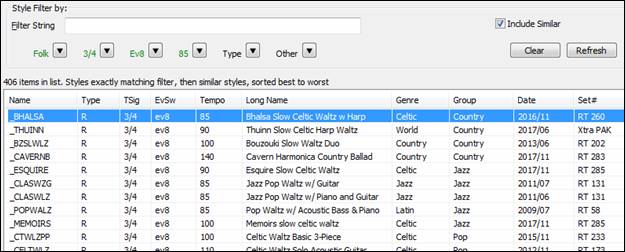
Quick filter

Another easy way to find a style is using the text filter. For example, if you want to find punk styles, simply type “punk” and the list will be filtered to show punk styles. If there is a RealTracks musician that you want to check out, just type in his name, and the list will show styles with that musician in them.
You can also use the arrow button to select a category, time signature, feel, etc., and you will immediately see the filtered list.
![]()
Category - This lets you filter styles by a genre or category.
TimeSig - This allows you to filter styles by the time signature.
Feel - This sorts the list by feel (even 8th, swing 8th, even 16th or swing 16th).
Tempo - This sorts the list by the tempo.
Type - With this button, you can choose to display Real and/or MIDI styles. The default is to display Real styles first and MIDI styles at the bottom, but you can change the default selection with the last menu item.
Other - This is a miscellaneous filter. For example, the list can be filtered to show only your favorite styles, styles that use a specific RealTrack, or styles with soloists.
If “Include Similar” is unchecked, then the filtered list will show the exact match only, but if this option is checked, then the list will show the exact match and the similar styles. The [Clear] button will clear any filter so all styles will display.
Automatic intelligent sorting of “best style” for the current song
![]()
The StylePicker tells you how the list is currently sorted.
Instant Preview of Styles
You can audition a style without changing your existing arrangement, by using the preview control.

It has Play and Stop buttons, a progress bar, a Loop button and a file button.
![]() Also, when the control is playing, if there are 2 files that can be played, there is a toggle button displayed. This appears for previewing MIDI styles, because there are MIDI drums and RealDrums available for most MIDI styles, and now you can easily hear both.
Also, when the control is playing, if there are 2 files that can be played, there is a toggle button displayed. This appears for previewing MIDI styles, because there are MIDI drums and RealDrums available for most MIDI styles, and now you can easily hear both.
![]() To hear a preview, simply double-click on a style name in the list. Or highlight a style and press this button.
To hear a preview, simply double-click on a style name in the list. Or highlight a style and press this button.
The demos are pre-made, so they play instantly. And they are a good idea of what the style is supposed to sound like.
The style demos are found in 2 possible places:
1. On your hard drive, in the Data\Style Demos Audio folder of your RealTracks folder, usually C:\bb\RealTracks\Data\Style Demos Audio (some of the demos are included on disk, but to save space not all of them are included).
2. On the Internet, at www.pgmusic.com (all of the demos are there).
When you demo a style, the program will play the version on disk if available; otherwise will play from the Internet. ![]() The style demos sometimes play files from the internet. You can download a file that is being played from the internet by clicking this button. If the file is being played on your hard drive, this button will show the file in a folder.
The style demos sometimes play files from the internet. You can download a file that is being played from the internet by clicking this button. If the file is being played on your hard drive, this button will show the file in a folder.
![]() This button allows you to control the volume of demos.
This button allows you to control the volume of demos.
Play Your Song with the Styles
You can also audition a style by actually playing it over the current chord progression of your song.
![]()
|
The [Play] button will generate arrangement for your song with the currently highlighted style. The [Stop] button will stop playback. |
![]() You can speed up the generation if you enable this option, which will play only for the first 4 bars.
You can speed up the generation if you enable this option, which will play only for the first 4 bars.
|
The ideal tempo for the style is shown here but you can change it to any tempo by typing in the number or clicking on the [+] and [-] buttons. You can even change it during playback. |
![]() This will open the pre-made demo song for the currently selected style.
This will open the pre-made demo song for the currently selected style.
Sortable and sizable columns
The styles list can be easily sorted by clicking on a column name. Clicking again will reverse the order. You can also resize the column width by dragging a column border.
Each column provides following information for the style.
Name : This column shows the file name of the style.
Type : This column tells you whether the style has RealTracks only (“R”), MIDI only (“M”), or a combination of RealTracks & MIDI (“RM”)
TSig : This column shows a time signature (4/4, 3/4, etc.) of the style.
EvSw : The “ev” or “sw” indicates whether the style plays in an even feel or a swing feel.
Tempo : The tempo shown here is the tempo set in the style.
Long Name : This column shows the full name of the style.
Genre : This column shows the genre of the style.
Group: The styles are grouped into three groups: Pop, Jazz, and Country. This column also shows a "genre score," which describes a style by a simple number from 1 to 100. This works as follows: quiet, classical, acoustic, jazz, or folk would have low genre scores (1 to 30); loud, aggressive, or heavy rock would have high genre scores (80-100); and light-medium pop would have mid-range genre scores. You can filter the style list by the genre score with the "Other" filter button either by choosing a pre-defined range or setting your own custom range. For example, if you're looking for a quiet "living room" type style, use the filter to only show styles with a genre score less than 40. This might show jazz, classical, folk or other quiet-acoustic styles.
Date : This column shows the date when the style was made.
Set # : In this column, you can see which set includes the style.
# Instr : This column shows the number of instruments that are present in the style.
# Substyles : A style can contain as many as 24 substyles.
Other Genres : This column suggests additional genres of the style.
Customization
The mixer-like control shows what tracks and instruments are used in the currently selected style in the list, and color-codes them according to the track types (MIDI, MIDI SuperTracks, or RealTracks).
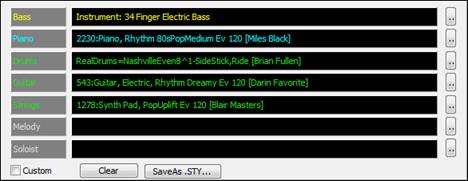
For each track, there is a menu button, which allows you to change the instrument, disable/enable the track, or perform other track actions. Previously, you had to close to the StylePicker window to do these.
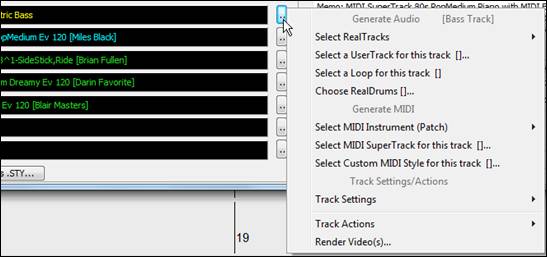
When the track is customized, an asterisk will be added to the name.
![]()
When the “Custom” option is checked, the tracks of the currently selected style will be overridden with the choices you have made.
The [Clear] button will clear any customized settings.
Press the [Save as .STY] button to save the style that you have customized. When you save the style, it will be added to the StylePicker list.
Memo
This area shows additional information about the style. You can see instruments, artists, a brief description, and song examples currently selected style. If the style has Loops or UserTracks, you will see the names of the Loops or UserTracks.

Action
![]() Clicking on this button shows you a menu with options to select/create User Category, add the current style to the User Category, set styles as a favorite, etc. These options are also available when you right-click on the list.
Clicking on this button shows you a menu with options to select/create User Category, add the current style to the User Category, set styles as a favorite, etc. These options are also available when you right-click on the list.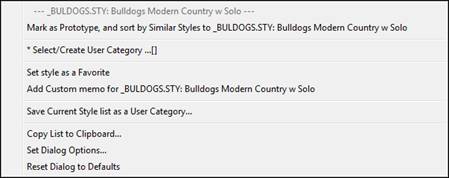
Mark as Prototype, and sort by Similar Styles to
This menu item will sort and filter the list by best to worst match of the prototype’s tempo, feel, genre, time signature, and more. Once you do this, the sort status indicator will tell you that the sort is by prototype. ![]()
For example, if you choose _BUBLPOP as the prototype style, the list will be sorted with styles most similar to _BUBLPOP. These are the styles with a similar genre, feel, tempo, and time signature. Here is an example of the results of setting _BUBLPOP as the prototype.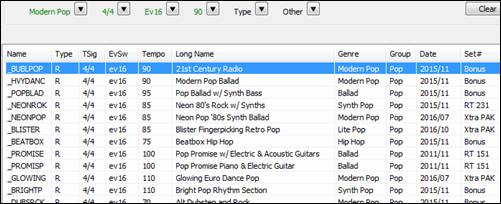
Select/Create User Category
Unlimited User Categories can be created by users or third parties, to list their styles in the StylePicker.
To select an existing User Category, choose Select/Create User Category. When the dialog opens, select a category and press the [OK] button.
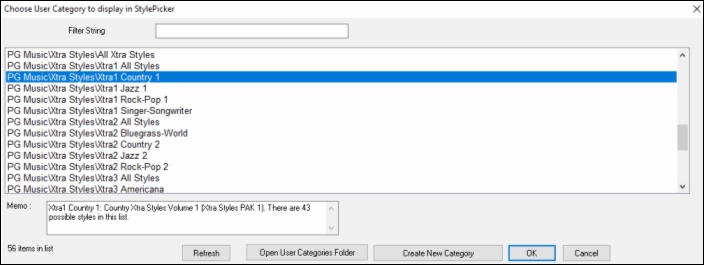
To make your own User Category, right-click on the list, choose Select/Create User Category, and when the Choose User Category to display in StylePicker dialog opens, press the [Create New Category] button.
Type a name for your category and click on the [Save] button.
![]()
You can also enter a memo for your category.
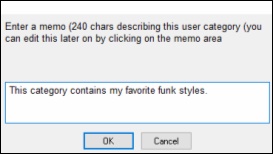
|
You can re-arrange this folder by creating subfolders and moving the categories around to organize them. You can also directly edit the .txt file in this folder. |
![]() If you have made any changes to this folder, remember to press the [Refresh] button.
If you have made any changes to this folder, remember to press the [Refresh] button.
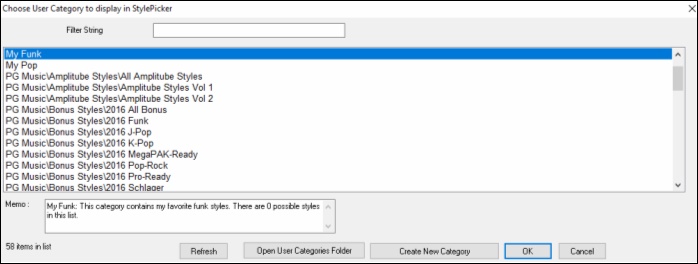
User Categories are analogous to playlists in a song player. You can create/edit them and choose to display only the styles from the category or all styles with the category styles highlighted with a * asterisk.
Add Style to Current User Category
This menu item adds the currently selected style to the current User Category.
Save Current Style list as a User Category
This menu item allows you to create a new User Category and add all the styles currently displaying in the list to the new category.
To display only the styles from the current User Category, click on the [Category] button above the list and select Show this User Category. If you want to see only the styles from another User Category, select Choose and Show User Category and choose a User Category from the list.
![]()

You will then see styles from the selected User Category.

Set Style as Favorite
This menu command will set the selected style as a favorite. If the style is already a favorite, you can select the Remove style as a Favorite menu item.
Rebuild of Styles List
![]()
Press the [Rebuild] button and select Partial Rebuild of Styles List after you install new styles from PG Music. It takes about 30 seconds to rebuild the list. The Complete Rebuild Styles List menu item will find not only PG Music styles but also new or changed user or third-party styles. It takes longer to rebuild the list.
Copy List
The Copy List to Clipboard menu item in the [Action] button saves the current list with all information to a tab-delimited .txt file and opens it in Notepad. In Notepad copy all and paste it into a spreadsheet such as an Excel file. You can then apply a hierarchical sorting of the list.
Defaults
The Reset Dialog to Defaults menu item in the [Action] resets the dialog to default settings.
Options
The Set Dialog Options menu item in the [Action] button opens the StylePicker Options dialog with additional options for the StylePicker.
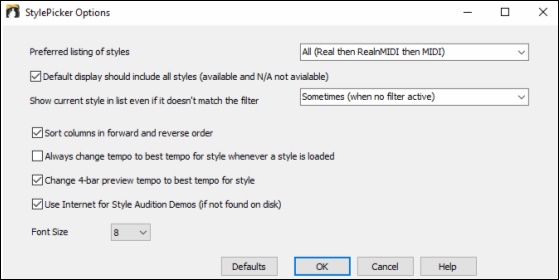
Preferred listing of styles - This controls the default type of listing of styles (Real and/or MIDI).
Default display should include all styles (available and N/A not available) - If this option is enabled, you will see all styles including N/A ones even when all filters are cleared.
Show current style in list even if it doesn’t match the filter - This setting lets you choose to always show the current style even if it doesn’t match the filter.
Sort Columns in forward and reverse order - If this option is enabled, clicking on a column name again will sort the list in reverse order.
Always Change Tempo to best tempo for style whenever a style is loaded - If this option is checked, pressing the [OK] button in the StylePicker will always change the current tempo to the ideal tempo for the selected style. Note: If the song is “blank” (no chords past bar 5), then the tempo will change, but if the song has chords in more than 5 bars, then the tempo will not change unless this option is enabled.
Change 4-bar Preview tempo to best tempo for style - If this is checked, then when you preview the song, it will be played at the ideal tempo for the style.
Use Internet for Style Audition Demos (if not found on disk) - Enable this option so demos will play files from pgmusic.com using the Internet if demos are not found on disk.
Font Size - This allows you change the font size of the styles list.
[Defaults] - Press this button to set all options to default settings.
Song Titles Browser
The popular Title feature, which allows you to type in the name of a familiar song and find a style with similar feel and tempo, has been enhanced with a dedicated Song Titles Browser window. This window allows you to browse and filter the huge list of over 21,000 popular song titles. You can, for example, filter by a certain artist, and then sort all the songs by tempo, key, feel, time signature, and more.
You can open this window by pressing the [Find Titles] button.
![]()
If the StylePicker window is not open, you can open the Song Titles Browser window by clicking on the [Style] button and selecting the Choose style from Song Title menu item.
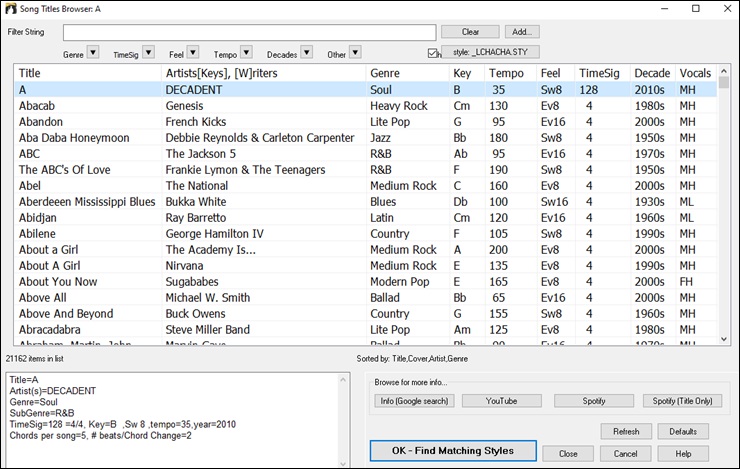
There are Title/Artist/Genre/Key/Tempo/Feel/TimeSig/Decade/Vocals columns. You can sort the list by any column.
![]()
You can filter the list by genres, time signature, feel, tempo, decades, and more.
![]()
The chord density filter is available. Press the [Other] filter button and select one of the menu items below Filter by Chord Density. For example, you can search titles in which chord changes every 1-4 beats. You can also filter the list by chord complexity. This is scaled by 1 to 10; 1 means simple with few chord changes and 10 means complex with many chord changes. Press the [Other] filter button and select one of the menu items below Filter by Chord Changes.
You can see song titles that will only work with the current style.
![]()
Pressing the [style: ] button will filter the list by the genre, time signature, feel, and tempo of the current style. If the checkbox to the left of this button is enabled, then when you open the dialog, the list will be automatically filtered to show song titles that are similar to the current style.
If you do not see a song title you are looking for, press the [Add] button. This will launch your internet browser and open the PG Music forum page where you can request to add the song to the database.
The buttons in the Browse for more info area will launch the internet browser and let you browse for more info for the selected song or listen to the song.
Once you have found a song, press the [OK - Find Matching Styles] button. This will take you to the StylePicker window with styles that best match the tempo, feel, and genre of the selected song title.
Favorite Styles / Recently Used Styles
|
Other options in the Style button menu include Recently Used Styles and Favorite Styles. They open a dialog with separate lists of Recently Played and Favorite styles. |
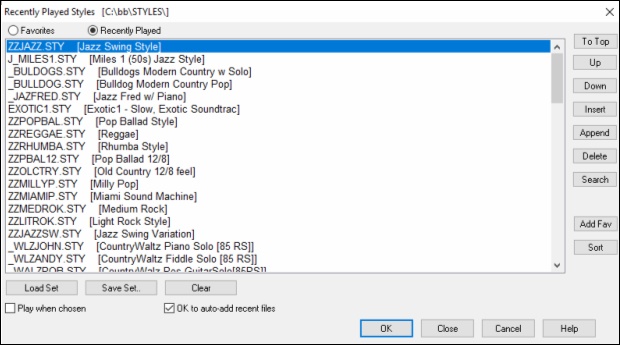
You will see Favorites and Recently Played radio buttons that toggle between lists of recently played styles and your favorite styles
The favorites list will start off as an empty one. You can add styles as your favorites by clicking the [Add Fav] button. A similar button is found in the StylePicker window.
Use the [To Top], [Up], and [Down] buttons to navigate the list.
Use the [Insert], [Append], and [Delete] buttons to modify the list
The [Search] button will search for a style in the list by name, or part of a name.
The [Sort] button sorts the list alphabetically.
The [Load Set] and [Save Set] buttons allow you to save and load sets of Favorites or Recently Played styles.
Use the [Clear] button to clear the list and start a new one.
Enable the Play When Chosen option have Band-in-a-Box play your song immediately upon selecting a style.
If OK to auto-add recent files is enabled, every style you select will be added to the top of the list.
Style Aliases Dialog
The Style Aliases selection is found in the File | Load Style Special submenu.
Let’s say you’ve got a new style for Jazz called “J_DIZZY.” You can create an alias so that when Band-in-a-Box looks for a Jazz Swing style, it will load in “J_DIZZY” instead, so you don’t have to make changes to all your songs. And when you have found a new favorite style, just change the alias. You can also load or save sets of “Alias” files and share them with others.
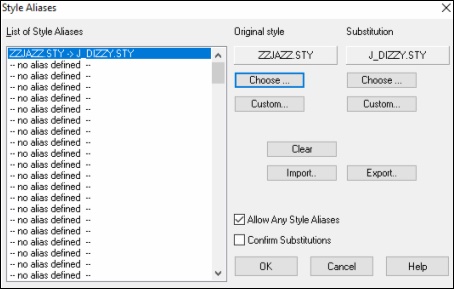
To type in a style name that you don’t have, use the [Custom] button.
To create a new alias, click on an empty spot (i.e. no alias defined) in the alias list, or click on the alias you wish to edit if you wish to change an existing alias. Press the [Choose] button below the Original style box and select the style you wish to be replaced. Press the [Choose] button below the
Substitution box and select the replacement style (alias).
If you have made a mistake and wish to change your style selection, press the [Clear] button. When you have successfully made an alias, you will notice that there will be a small arrow in the Styles box on the main screen indicating that you have an alias loaded.
You can Export and Import alias files to share with your friends by clicking the [Import] button to open an alias file, or click the [Export] button to save an alias file.
Enable/Disable Style menu item
The File | Load Style Special submenu has an item to Enable/Disable the style. When a style is disabled, the name of the style will have an X at the beginning, which indicates a disabled style. The disabled style won’t sound or write any data to the MIDI file. The most common use for disabling a style is when a MIDI file is loaded to the Melody track. Then the style won’t sound and conflict with the full arrangement on the Melody track.
Forced Styles option
This allows you to keep a style in memory. This way, all subsequent songs that are loaded will not change the style (even if they have a different associated style), so you can easily play songs in the same style. If you’ve found a new favorite style, you can try it out in all kinds of songs without having to reload the style each time.
For example, let’s say we’ve discovered the “GARNER” style, and want to try it out on all kinds of songs. Select File | Load Style Special | OK to load styles with songs so that the item is NOT checked. Now when you load a song the new style doesn’t load and you can play the song in GARNER.STY. You can temporarily override this setting by loading in another style using the [Style] button or the File | Load Style Special menu, and the new style loaded will stay in until you choose another one.
Using MultiStyles
Band-in-a-Box MultiStyles are styles that can have up to 24 substyles; original Band-in-a-Box styles had two substyles, “a” and “b.” Band-in-a-Box MultiStyles typically have four substyles, but may have up to twenty-four, selected by using part markers “a” through “x.”
You can easily make your own MultiStyles, either from scratch, or combining parts from existing styles to make a MultiStyle. For example, if you have 10 favorite Country styles, you can quickly make a single MultiStyle that has 20 substyles available within the same song.
There are 2 types of MultiStyles.
- MultiStyles in styles, working for every song (e.g. NR_CURR+.STY Nashville Rock Current Multistyle).
- MultiStyles for a specific song only.
MultiStyles in Styles (“+” Styles)
Styles can be made that have multiple substyles, and you can choose the various substyles using the letters a, b, c, d, etc. up to “x” for 24 substyles.
Our naming convention for MultiStyles is to use a + sign at the end of the style name. For example, MyStyle+.STY would be a MultiStyle.
You can use these substyles easily; just enter the StylePicker and filter the styles list by the “+” character. |
For example, load the song NR_CURR+.MGU from the C:\bb\Documentation\Tutorials\Tutorial - BB2008 folder. This loads the NR_CURR+.sty. When you see the “+” in the style name, you will know that this is a MultiStyle.

Right-click on a part marker, and you will see that there are 4 substyles available.
In the style NR_CURR+, there are 4 substyles, a, b, c, and d.
Standard Pop Song form with 4 substyle MultiStyle
In NR_CURR+ (and as a general rule for styles with 4 substyles):
- “a” substyle is for the verse.
- “b” substyle is for the chorus.
- “c” substyle is for the intro (or first verse).
- “d” substyle is for the break (or interlude).
|
Choose your substyle by clicking on the part marker, or right-clicking to select and define substyles. Here we have chosen “c” substyle, appropriate for the intro or first verse of the song (because the playing is sparse and sustained). |
Making your own MultiStyles in Styles
You can make a style that is a MultiStyle.
1. Open the StyleMaker.
2. Press the [Misc] button.
3. In the MultiStyles group box, type the name of a style that you would like to use for the c/d section.

If you’d like more substyles, add more styles separated by semicolons (e.g. “zzjazz;z5bossa;c_george”). Then you’d have 8 substyles from “a” to “h.”

Note that each of these styles can have a specific RealDrums style, either stored in the style itself (Misc. Style Settings “RealDrums Settings”) or substituted via MIDI substitutions in RealDrums settings.
Naming MultiStyles
Styles can have names stored for the substyles. This is especially useful for Multistyles to describe the various substyles.

|
The MultiStyle names are set in the StyleMaker Miscellaneous dialog. When present, the names are visible with a right-click on a bar number. |

MultiStyles in Songs
If you have a song, you can also use more than 2 substyles for that song. For example, let’s say we have a song that is a Bossa Nova and you want to have a Jazz Swing section. Rather than finding a MultiStyle that has this exact combination, we can make one, in the song, for this song only as follows:
Load a song like C:\bb\Demos\MIDI Style Demos\Styles00\zzbossa.mg4.
Right-click on a bar number, and choose “Define c/d.”
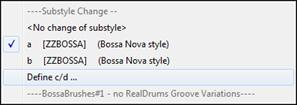
Then choose ZZJAZZ.STY from the StylePicker.
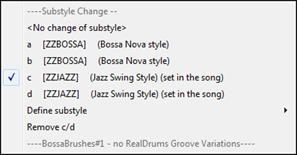
You will then see that there are 4 substyles now, a, b, c, d. You can use the “d” substyle for Jazz Swing walking bass, since it is the same as the “b” substyle from ZZJAZZ.
Load the song C:\bb\Documentation\Tutorials\Tutorial - BB2008\Demo of MultiStyle in song only Bossa 2 Jazz.MG4, and you can see the finished result. This song switches styles using part markers.
Adding MIDI SuperTracks
What are MIDI SuperTracks?
MIDI SuperTracks are MIDI tracks that can be added to a track or a style and play like other MIDI tracks in a style. They are called “SuperTracks” because they are generated using a different engine than typical MIDI style tracks. Typical MIDI style tracks are generated from C7 patterns in the style and repeat these patterns over any chord. MIDI SuperTracks use actual MIDI playing from musicians (similar to RealTracks in that regard), so are not based on patterns.
Using MIDI SuperTracks
To use MIDI SuperTracks, either:
- Choose a style or song that has MIDI SuperTracks and press Play. Look in the MIDI SuperTracks Demos folder for these songs
- Add a MIDI SuperTrack to a certain track.
Adding a MIDI SuperTrack
For example, let’s add a MIDI SuperTrack to the Piano track.
![]() Right-click on the Piano track label at the top of the screen to see a menu of options (or right-click on the Piano track label in the Mixer), then choose “Select MIDI SuperTrack for this track.”
Right-click on the Piano track label at the top of the screen to see a menu of options (or right-click on the Piano track label in the Mixer), then choose “Select MIDI SuperTrack for this track.”
![]()
You will now see a menu of available MIDI SuperTracks. You can type a text or press the filter button [#] to narrow down your search.

You can type a text or press the filter button [#] to narrow down your search.
There are memos describing the individual MIDI SuperTracks, and you can click on the memo for a big window.
You can preview the MIDI SuperTracks by double-clicking on the list or using the transport control buttons.
Pressing the [Artist Bios] button opens the Artist Browser which lists all RealTracks artists and allows you to see more info.
Choose a MIDI SuperTrack from the list and click [OK].
![]() Once you choose a track, you will see that the Piano label has turned blue to indicate that it is a MIDI SuperTrack.
Once you choose a track, you will see that the Piano label has turned blue to indicate that it is a MIDI SuperTrack.
When you press Play, you will hear a much more sophisticated MIDI arrangement than a typical MIDI style, since it is not based on C7 chord patterns; instead, it is based on hours of actual MIDI playing from a top studio musician. |
|
You can also access the MIDI SuperTrack dialog from the RealTracks Picker, by pressing the [Super] button. |
Once you have selected a MIDI SuperTracks, you might want to assign a specific VST/DX instrument to play it. If so, use the Mixer’s Plugins panel, and click on the first slot for the track that you want to set.

This will open the selected plugin window.
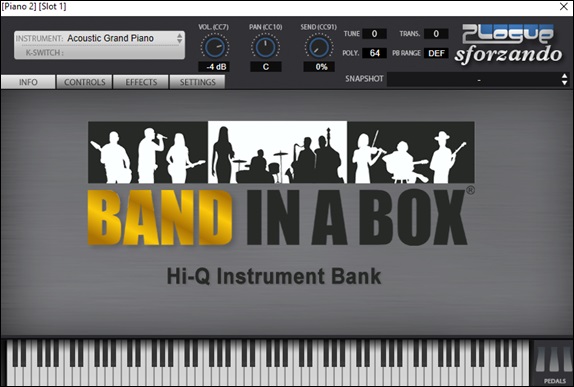
Each MIDI SuperTrack is assigned a number, like the MIDI Soloists or the RealTracks, so you can access the MIDI SuperTracks from the Select Soloist dialog as well, and they are highlighted in cyan.
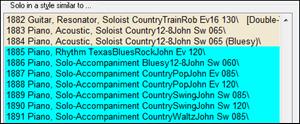
Once generated, MIDI SuperTracks behave like a regular MIDI track, and can be saved as MIDI files etc.
Using RealTracks in Songs
Your songs, styles, and solos can use live audio tracks recorded by studio musicians. Many Band-in-a-Box styles already use these tracks, and you can substitute these live recordings for the Band-in-a-Box MIDI tracks in any song.
Using RealTracks in Songs - Assign RealTracks to Track Dialog
The Assign RealTracks to Track dialog assigns a RealTracks instrument to any of the Band-in-a-Box instrumental tracks. It also shows any RealTracks that are assigned to Band-in-a-Box tracks.
This dialog is launched by several ways.
- Click on the [RealTracks] toolbar button and select RealTracks Picker Dialog, or shift-click on this button.
- Right-click or double-click on a Track button at the top of the main screen or in Mixer and choose Select RealTracks from the menu.
- Press the [Assign to Track…] button in the RealTracks Settings dialog.
- Press the r t Enter keys.
The dialog allows you to assign a specific RealTracks instruments to a track in a song. It also displays any RealTracks that are currently assigned to each track.
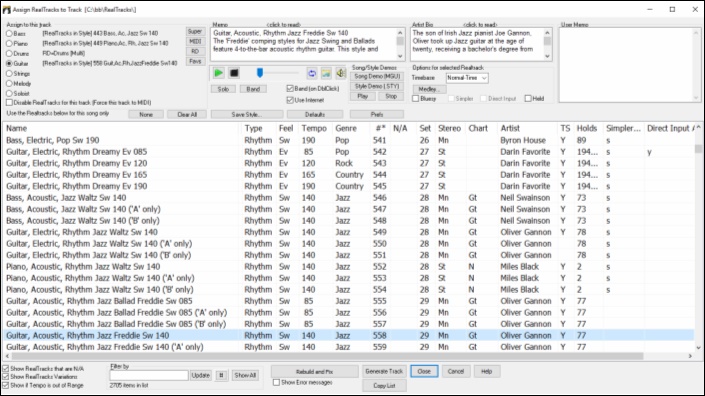
To use the dialog, first select the track that you want to assign.
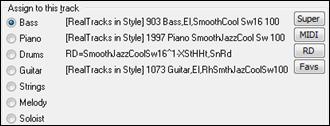
Then, select the RealTracks that you want in the list below it.
Instant Preview of RealTracks
You can instantly hear an audio demo of RealTracks by double-clicking a RealTrack on the list. Since this doesn’t affect your song, you can quickly audition many different RealTracks, and find the best ones for your song.

You can choose which of band or solo plays first when you double-click on the list, by the “Band (on DblClick)” checkbox. Otherwise, press the [Band] or the [Solo] button. The demos play from the Internet or your hard drive (C:\bb\Demos\RealTracks-Demos).
Changing RealTracks
You can change RealTracks within a song.
There are 2 ways to change RealTracks at any bar.
1. Change of RealTracks Styles at any Bar
You can change styles with RealTracks at any bar. For example, switch from Jazz Swing to Bossa style at any bar. To do this, first open the Edit Settings for Bar dialog (press F5) at the bar where you want the style change. Then press the [STY] button to select a style change.

Note: If the track type changes by the style change, the track will be silent from the current bar. For example, when the style with a MIDI piano track is selected for the song, if you select a style with a RealTrack piano track at the current bar, the piano track will be silent after the style change.
2. Change of individual RealTracks instrument can be added to any track at any bar
You can change specific RealTracks without changing the style by inserting a specific RealTracks instrument into a track at any bar to create a customized performance. For example, if you want to change an Acoustic Bass comping part to an Acoustic Bass Solo at Chorus 4, Bar 1, you can do this. To change a certain track’s RealTracks at any bar, first open the Edit Settings for Bar dialog (press F5) at the bar that you want the style change. Then press the [RealTracks] button and you will see the RealTracks changes dialog where you can choose which tracks you would like to have RealTracks changes on.

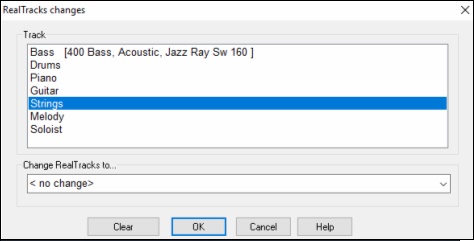
Select a track, then press the “Change RealTracks to” and you will then see a list of RealTracks.
You will see a huge list of RealTracks, so you will likely want to narrow it down. Type a word that will be included in the RealTracks name, like “bass.” Then the list will only show bass RealTracks.
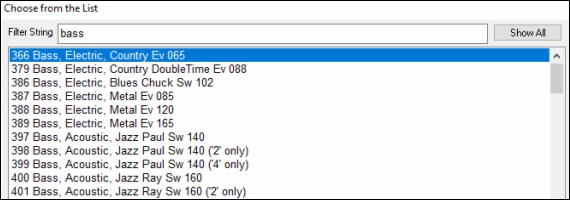
UserTracks
UserTracks allow anyone to create their own audio styles for use in Band-in-a-Box. With a UserTracks style, you can type in any chords into Band-in-a-Box, and the UserTracks style you made will play that chord progression! For example, if you’ve made a UserTracks style by recording yourself playing a guitar groove, you can then type any chords into Band-in-a-Box, and the result will be that it will play your guitar groove over these completely new, original chord changes!
You can use the UserTracks in a similar manner to using RealTracks.
![]()
![]()
To select a UserTracks for a track, first select the track at the top of the screen. For example, if you want to add a UserTracks to the Guitar Track, launch the menu on the Guitar track button (by right-click or double-click), and choose the “Select a UserTrack for this Track” option.
|
An alternative to the menu would be to select the Guitar track, and then press the UserTracks button on the main screen. |
Now you will see the Pick a UserTracks dialog.
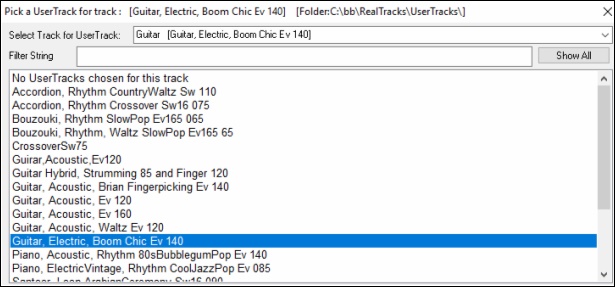
You can preview the selected UserTracks by double-clicking on the list or using the transport control buttons.
![]()
|
You can select a timebase (normal, half-time, double-time, or triple-time) for any UserTracks. |
In this example, we want to add the UserTracks called “Guitar, Electric, Boom Chic Ev 140.” We simply select this UserTracks and press OK. We now see our UserTracks listed on the Guitar track on the Mixer.
![]()
|
Now the track behaves like other RealTracks. |
Using RealDrums in Songs
There are several ways to hear RealDrums with new or existing Band-in-a-Box songs.
Many styles already use RealDrums, and there are several ways to tell if your song is using them.
![]() At the top of the screen, the status bar will display the name of the set if RealDrums are in use.
At the top of the screen, the status bar will display the name of the set if RealDrums are in use.
![]() You will see that the “Drums” radio button is colored in green.
You will see that the “Drums” radio button is colored in green.
Right-click on “Drums” and a menu opens that includes the name of the RealDrums in the style. Click on this menu item to open the RealDrums Picker and select a different set.

You can also press the r d Enter keys to open the RealDrums Picker.
RealDrums can be added to any track, not just the Drums track, so you can have more than one drums track. To do this, right-click on the track button and select Choose RealDrums from the menu.
|
The RealDrums Picker can also be opened directly by clicking on the [RealDrums] toolbar button and selecting RealDrums Picker Dialog menu item. This action selects a RealDrums for the current song. It does not change the RealDrums set used in the style. |
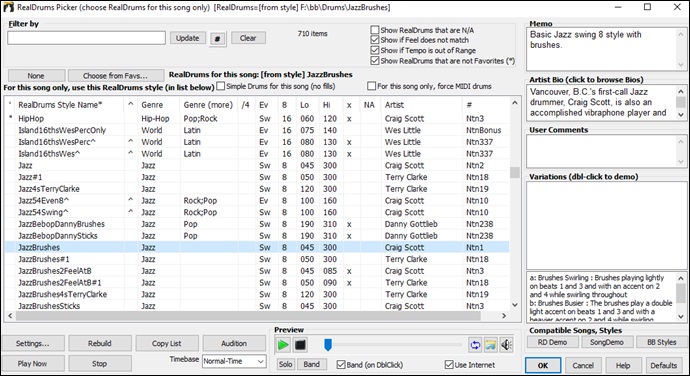
Preview: You can double-click on a RealDrums or on the Variation name of the RealDrums, to audition each variation of the RealDrums. For example, if you’ve found CountryWaltz^, you can now hear demos of the variations (CountryWaltz^1-HiHat,Ride, CountryWaltz^2-Brushes etc.).

Each demo has a “band” version with all instruments, and a “solo” version with drums only. You can choose which of band or solo plays first when you double-click on the list, by the “Band (on DblClick)” checkbox. Otherwise, press the [Band] or the [Solo] button. The demos play 4 bars of “a” substyle, and then 4 bars of “b” substyle, using the current RealDrums (left hand panel) and the variation (right hand panel).
![]() The preview sometimes plays files from the internet. You can download a file that is being played from the internet by pressing the folder button. If the file is being played on your hard drive, this button will show the file in a folder.
The preview sometimes plays files from the internet. You can download a file that is being played from the internet by pressing the folder button. If the file is being played on your hard drive, this button will show the file in a folder.
![]() You can control the volume of the demos with the speaker button.
You can control the volume of the demos with the speaker button.
Press [OK] to make your selection.
Press [Cancel] to close the dialog without making a selection.
RealDrums QuickList
This is the simpler dialog for choosing RealDrums, an alternative to the RealDrums Picker. It displays all available RealDrums in a simple list, which can be easily filtered by genre, time signature, feel, and more. The list can be set to show only RealDrums that are compatible with the current style of the song. You can also set the highlighted RealDrums as a prototype RealDrums to find alternates to that RealDrums.
|
To open the dialog, right-click on the Drums track button, and select [QuickList] RealDrums in Song from the menu. |
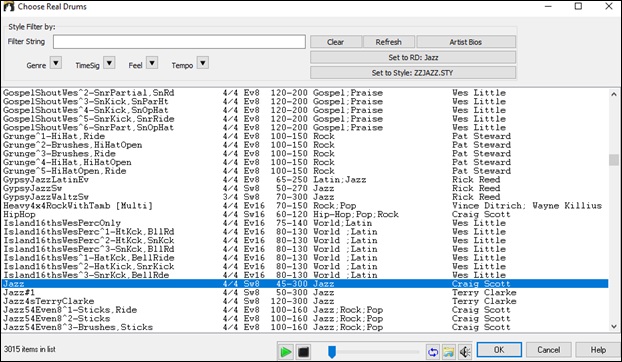
You can filter the list by genre, time signature, feel, tempo, and text. Use the [Set to Style: ] button to see RealDrums that are compatible with the current style of the song. The [Set to RD: ] button allows you to set the highlighted RealDrums as a prototype RealDrums so you can find alternates to that RealDrums. Press the [Clear] button to clear any filter.
EZ Selection of Drum Grooves
Many RealDrums sets include variations, or different grooves. There is an easy way to select the different grooves within the song. Simply right-click on a bar number, and you see a menu of the DrumGrooves within the style. So, for example, you could easily switch from the “side stick/hihat” groove to “snare/Ride.” These are RealDrums with names that end with a caret (^) like CountryPopEv16^.
![]() You can access the Drum Grooves to select them at any bar, by right-clicking on the bar #. You then see a menu of all the DrumGrooves.
You can access the Drum Grooves to select them at any bar, by right-clicking on the bar #. You then see a menu of all the DrumGrooves.
For example, one DrumGroove is “Snare, HiHat” and another one is “Snare, Ride.” You can switch the Grooves at any bar, so that the Drum part is more interesting.

The menu item Apply Drum Groove change to allows you to select which chorus the change of DrumGroove should apply to (default is all choruses).
Note that the changes of Drum Grooves are entered in the F5 bar settings dialog.
Assigning Custom MIDI Tracks
You can add MIDITracks individually (from any style) to play on any track of your current song. For example, let’s add a “MIDI strings” track to the Strings track.
|
Select the Strings track and then click on the [MIDITracks] toolbar button and select MIDITracks (from .STY) menu command. Or you can right-click on the Strings track button at the top, and choose Select a Custom MIDI style for this track. |
The MIDI Track Picker dialog will open.
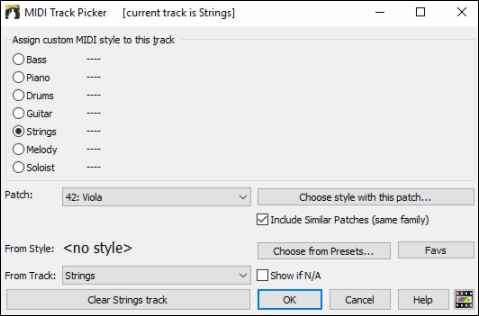
You can select MIDI parts a few different ways.
The [Choose Style with this patch] button launches the StylePicker, filtered to only display styles that contain the instrument specified.
![]()
For example, if you select “49 Strings,” it will only show MIDI styles with strings.

The [Choose from Presets] button launches a dialog with preset “popular” choices for MIDITracks to add. You can type a filter like “49” to only see entries for “49 Strings,” or type “strings.” This dialog shows you if the instrument is for “a” or “b” substyles or both (“ab”).

The [Favs] button will remember your last few hundred choices, so you can re-use them.

Once chosen, the MIDI track will play on the track chosen. Note that you can use the Strings track from a style and play it on any Band-in-a-Box track, including Bass/Piano etc., and even the Melody or Soloist track.
When you assign an instrument to a different track Band-in-a-Box will open a yellow message box to confirm your choice.
Press [OK] to continue or [Clear] to redo your choice.
Tutorial Demo Song – Adding MIDITracks
To check out a song that has had two individual MIDITracks added to it, open this folder: C:\bb\Documentation\Tutorials\Tutorial - BB2012, and open the file <=HANKMID Demo (MIDI Presets used over a country swing style).SGU>.
![]() Press the [Memo] button to read about the feature and the demo song.
Press the [Memo] button to read about the feature and the demo song.
Adding Loops to Tracks
You can add your own or third-party loops to any Band-in-a-Box track. Loops are audio files (WAV, wma, m4a, mp4, mp3) that reside in the Loops folder of the RealTracks folder. You can add your own files to this folder.
Loops support many types of ACIDized Loops (for WAV and mp3 files). And, if you add an Acid loop that is on a certain root (e.g. F), Band-in-a-Box will instantly allow you to use that as a complete style, by transposing that loop to the current chord of the song in Band-in-a-Box, so that the loop follows your chord progression.
|
Click on the [Loops] toolbar button to open the Pick a Loop dialog. |
You can also right-click on the track that you want to use at the top of the screen (e.g. Strings) and choose the menu item Select a Loop for this track.
When the dialog opens, select a loop from the list.
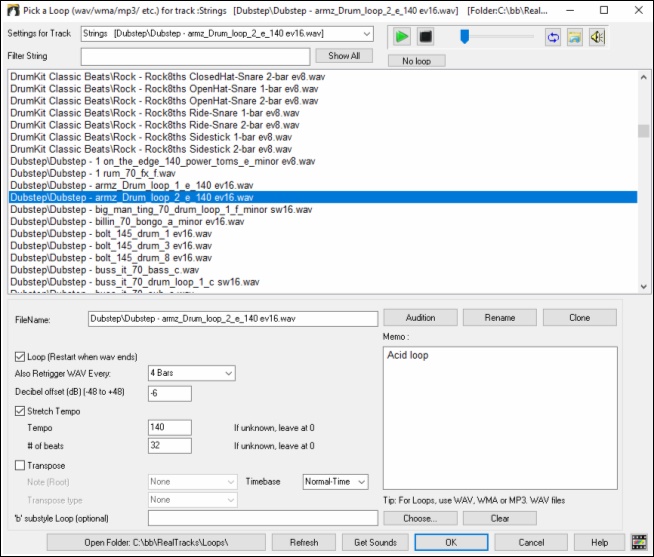
Double-click on the list or use a transport control button to preview the loop. The instant preview sometimes plays demos from the internet. You can save any file that is being played from the internet by clicking the folder icon.
![]() You can control the volume of the demos with the speaker icon in the transport control.
You can control the volume of the demos with the speaker icon in the transport control.
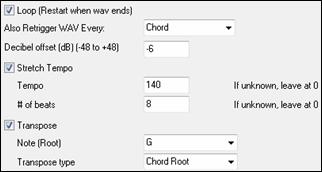
For a nature sound, you can leave these options at the default values. But if you want to retrigger the WAV every section, part marker, bar, or chord, then you can set them.
![]()
For a nature sound, there is no tempo, and you don’t want to select Stretch Tempo. For a Drums loop, you want to stretch the tempo. Once you select “Stretch Tempo,” enter the tempo of the WAV file (if known), and if not known, enter the # of beats in the wav file (e.g. 2 bars would be 8 beats).

For a nature sound, you don’t want any transposition. For a melodic sound, you might want to transpose to the root of the chord in the Band-in-a-Box song. If so, enter the root of the WAV file, and set the Transpose type to “chord root.”

The Timebase option allows you to select a timebase (normal, half-time, double-time, or triple-time) for any Loop.
If you want a different sound for the “b” substyle, enter that WAV file name in the 'b' substyle loop setting.
The [Open Folder] button opens your Loops folder and allows you to add audio files (loops) to it. If you add files, you need to press the [Refresh] button, or exit the dialog and re-enter it to refresh the list.
There are many good sources for loops and sounds on the Internet. One is freesound.org, which has many sound effects. The [Get Sounds] button launches your internet browser to search for free loops.
Pressing the [No Loop] button is a quick way to clear a loop on a track, as opposed to scrolling up to “No Loop chosen for this Track.”
The [Rename] button allows you to rename a loop.
The [Clone] button will duplicate a loop, allowing you to use it with different parameters.
Tutorial Demo Songs - Loops
To see the Loops feature in action, open this folder: C:\bb\Documentation\Tutorials\Tutorial - BB2012 and open one of these files:
_ELECTAM Demo (‘Loop’ feature with tambourine percussion added).SGU.
=THUNDER Demo (New Age style with Thunder Loop).MGU.
In the first example, a percussion loop has been added to a rock song, in the second example, a rain & thunder sound effects loop has been added to a New Age style.
|
When you play these songs, press the [Memo] button to read about the feature and the demo song. |
Utility Tracks
Band-in-a-Box has 16 editable Utility tracks, which can be used for audio and/or MIDI. You can generate RealTracks on the Utility tracks, where you can hear and edit the audio RealTracks, or view and edit the RealCharts MIDI. You can record audio or import an audio file to the Utility tracks to play, edit, or harmonize the audio. You can copy or move audio, MIDI, or both from other tracks to the Utility tracks. You can record MIDI or import a MIDI file to the Utility tracks for playback, notation display, or editing.
To generate RealTracks on a Utility track, right-click on that track in the Mixer and go to Generate | Select and Generate RealTracks. If you want to generate RealTracks for a region, highlight the region on the Utility track in the Audio Edit window. Then, select a RealTracks in the Best RealTracks dialog and press OK.

When the RealTracks is generated, you can view the audio in the Audio Edit window.

Press the [Play] button on the toolbar to hear the RealTracks on the Utility track. You can use the Mixer to control volume, panning, etc. for the Utility track.
![]()
You can regenerate a region of the RealTracks on the Utility track. To do this, Highlight the region, press the [Edit] button, and go to Generate | Generate RealTracks. If you want to regenerate a region using a different RealTracks, use the Select and Generate RealTracks menu item instead.

During the regeneration, the whole track becomes blank for a moment, but when it’s finished, everything except the highlighted region is the same as it was before.

You can repeat this process until you are satisfied, and since it supports the Undo and Redo, you can use the Ctrl+Z or Shift+Ctrl+Z keys to go back to what you like most.
The audio on the Utility tracks can be edited in the Audio Edit window with the [Edit] button menu, the right-click menu, or the standard hotkeys (e.g., Ctrl+C, Ctrl+V). For example, you can highlight a region and move it to another location of the track, or you can select the whole track, copy it, and paste it into another Utility track. When the regions are edited, the beginning and ending of the regions cross-fade to make a smooth transition, so you won’t hear unpleasant clicks or pops at the joints during playback.
You can harmonize the audio on any track, and send the separated harmonies to the Utility tracks. In the Audio Edit window, press the [Edit] button, and select Harmonize from the menu to open the Audio Harmonies dialog. Then, set the number of harmony voices and other options, select the source track, enable the “Output to separate tracks” option, and select destination tracks for each harmony voice.
When you save the song, the Utility tracks will be saved as audio files (.WAV) with the same name in the same folder. For example, if you save the song as MySong.MGU, Utility track #1 will be saved as MySong #1.WAV, Utility track #2 will be saved as MySong #2.WAV, etc. Then, next time you open MySong.MGU, these audio files will be loaded to the Utility tracks.
Adding Bar-Based Lyrics
You can enter lyrics in each bar on the Chord Sheet.
|
To enter lyrics, you first need to display the Bar Lyrics layer by clicking on the [Chord Display] toolbar button and selecting Layers | Bar Lyrics. |

If the song does not have any lyrics, the Bar Lyrics layer does not appear on most lines, but it appears on the row where the bar is highlighted. If you click on a bar on another row, the layer will appear on that row.

Double-click on the Bar Lyrics layer on a bar where you want to enter lyrics. This will change the color of the layer, which indicates that you can type in that location. You can use keys to navigate through the layer: TAB to go forward, SHIFT+TAB to go backward.
![]()
|
Type a lyric and press the TAB key. This will enter the lyric and move the editing bar forward. |

To edit lyrics, go back there by clicking on that bar or using the SHIFT+TAB keys, and then retype.
If you have entered lyrics that were supposed to be spaced out over some bars, go back to the bar, and use the arrow key to move the cursor to the beginning of the lyric that should be in the next bar. Then press ENTER. This will push that lyric to the next bar and shuffle the texts in the following bars forward as well.
Example: You realize that “once was lost” in bar 13 should have been “once was,” and lyrics in bar 14 should have been spread over some bars.
![]()
Press SHIFT+TAB to go back to bar 13.
![]()
Use the left arrow key to move the cursor to the beginning of “lost.”
![]()
And press ENTER. This pushes “lost” to bar 14 and “but now am found” to bar 15.
![]()
Use TAB or SHIFT+TAB to move through the bars, the left/right arrow keys to move the cursor within the bar, and ENTER or BACKSPACE to push lyrics, until the lyrics are in the correct bars.
![]()
The Bar Lyrics layer is designed so that you can even edit lyrics during playback.
Another way to enter lyrics is to copy lyrics from a text file and paste them directly to the Bar Lyrics layer.
First, prepare lyrics in the text file and copy them to the clipboard.
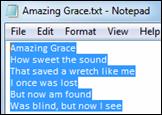
Then, go back to Band-in-a-Box, double-click on the bar where the lyrics should be inserted and press CTRL+V.
![]()
Now all the lyrics are entered in the layer.

But the lyrics are not quite in the correct bars, so you need to fix using the TAB, ENTER, or arrow keys.

There is an easier way for this copying and pasting method. If the lyrics in the text file are arranged so that each line represents a bar, you need very little to fix after pasting.
First, edit the lyrics in the text file so that every line corresponds to a bar. Then, copy them all to the clipboard.

Next, go back to Band-in-a-Box, double-click on the bar where the lyrics should be inserted and press CTRL+V keys.
![]()

Adding Melody – MIDI and/or Audio
Record a MIDI Melody
Band-in-a-Box is much more than an intelligent arranger and accompanist. You can record your live MIDI performance to the Melody or Soloist track, enter a melody in the Notation note-by-note, or use the Wizard feature to record with either your computer keyboard or a connected MIDI keyboard controller.
If you want a metronome to play while you are recording, you can select it in the Options | Preferences dialog. You can even have a visual metronome if you like.
| Press the [Record MIDI] toolbar button to begin recording. This launches the Record MIDI to Melody Track dialog, which prompts you to set the position (bar and chorus) where you wish to start recording. |
Pressing the [Record] button will start Band-in-a-Box recording what you play on the Thru track. An audible count-in is played prior to recording.

You can punch in/out, overdub, and record directly to the ending or the tag, and use the filter to choose which MIDI events are recorded. You can also select the destination track.
|
Once you have completed recording your melody, Band-in-a-Box will ask you if you would like to keep the take and if you would like to copy the recorded chorus to the whole song. If you did not record the full track you can choose to retain the rest of the track beyond the part you just recorded. |
Sequencer Mode
There are 2 tracks in Band-in-a-Box to add your own recordings. These are the Melody and Soloist tracks. Normally you would want a single part on each of them. But, since MIDI information can have separate channels, it is possible to store 16 separate parts on each of the Melody and Soloist parts. When the track has been set to “Multi (16) -Channel” we refer to this as “Sequencer Mode.”
If you want to use the 16 separate parts for the Melody track, you need to set the Melody Track type to “Multi (16) -Channel.” This is done from the Melody (or Soloist) menu or can be done by pressing the Sequencer button.
 |
|
Now, when you are in this multi-channel mode, output from the Melody track will be on whatever MIDI channel the information is stored on and will not be using the Melody MIDI channel. Both the Melody and Soloist tracks can be set to multi-channel play, for a total of 32 channels.
Embellishing the Melody
When musicians see a Lead Sheet that has a melody written out, they almost never play it exactly as written. They change the timing to add syncopation, change durations to achieve staccato or legato playing, add grace notes, slurs, extra notes, vibrato, and other effects. You can have Band-in-a-Box do these automatically using the Embellisher.
![]()
![]()
You can enable the Embellisher from the [Embellish Melody] menu button. Any Melody will be embellished as it is played so that you hear a livelier and more realistic Melody - and it’s different every time.
Embellisher dialog opens the Melody Embellisher dialog with many user options to control the embellishment settings. The Embellisher Presets allow you to choose a combination of common settings for the Embellisher quickly.
The Embellisher is only active while the music is playing; the recorded Melody track isn’t affected. There is an option for the Embellisher to only humanize the timing of the music if the timing was “stiff” to begin with. This allows the Embellisher to leave the timing of human input melodies alone and humanize only the ones that were entered in step-time.
|
The Embellisher Memo describes the current embellishment, with statistics counting the number of embellished notes. |
|
You can save/load your own presets for the Embellisher. |
When you want to recall the saved preset, press the Import button, and load in a previously made .EMB file. You can share your favorite presets with other installations of Band-in-a-Box using the EMB files.
Harmonize the MIDI Melody
|
Use the [Harmony] menu button command MIDI – Melody Harmony to add a MIDI harmony to the Melody track. This opens the Select Melody Harmony dialog where you can choose from any of the pre-defined harmonies. |
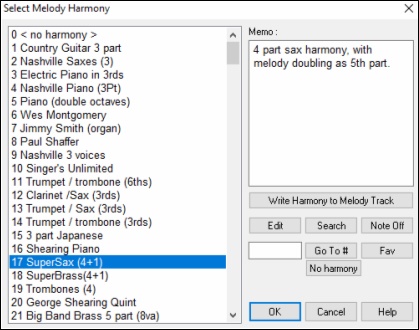
The [Edit] button will open the Harmony Maker, where you can customize Harmonists.
The [Search] button allows you to search for a harmony by a keyword (i.e. typing in the first few letters of a harmony name) in either the Harmonies or Favorite Harmonies dialog.
The [Note Off] button is to turn off any notes that are stuck on. (There shouldn’t be any.)
Enter the number of the harmony you want to go to and press [Go To #].
The [Fav] button will produce a list the 50 most recently loaded harmonies.
The [No harmony] will disable the harmony for the song. The keystrokes Shift+F10 also allow or disable the Melody harmony.
When adding a harmony to the Melody (or Soloist) you can use the option to loosen up start times of for the harmony notes to achieve a more natural, richer harmony sound.
Choose menu item Melody | Edit Melody Track | Quantize, Time Adjust | Loosen Start Times. You can select the range of adjustments. For example, if you want the notes to be played earlier, use a negative number. A setting of minus 5 to positive 6 would cause the start times to be varied up to 5 ticks early and 6 ticks late. There is also a setting to choose whether you want only the harmony notes present on the track to be affected, leaving the original melody unaffected.
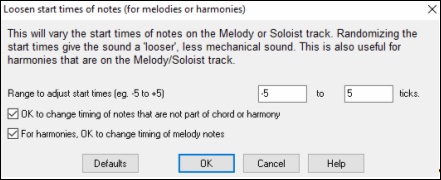
Convert Track to Harmony
![]()
![]()
This feature permanently writes the specified harmony to the Melody or Soloist track, instead of being applied in real time. Use the buttons in the Select Melody/Soloist Harmony dialogs, or the Convert Harmony… menu command found in the Melody and Soloist menus. You will then see a dialog allowing you to choose the range of the song to add the harmony, either the whole song or a specified range of bars.
There are options to “Eliminate Note Overlap” and “Loosen start times of notes” for the harmony notes to achieve a more natural, richer harmony sound. The melody is not affected, only the harmony notes, and there are options for the range of spread for the harmony notes.
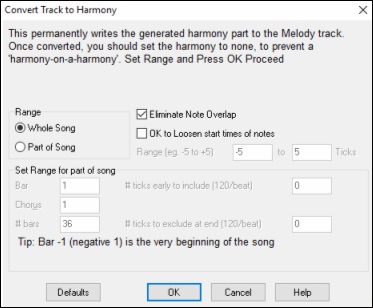
Record a Live Audio Track
You can record your live vocal or instrumental performance and save it to an audio wave file along with the Band-in-a- Box accompaniment. Make sure that you have a microphone plugged in to your sound card, or a connection from a mixer, keyboard, or other audio device connected to the Line In jack on your sound card.
|
Click on the [Record Audio] button to prepare to record an audio track. |
|
The VU Meters show the average strength of the signal, with a dB scale, and a clip indicator. Clipping indicates that the signal has overloaded and will sound distorted (clipped).
|
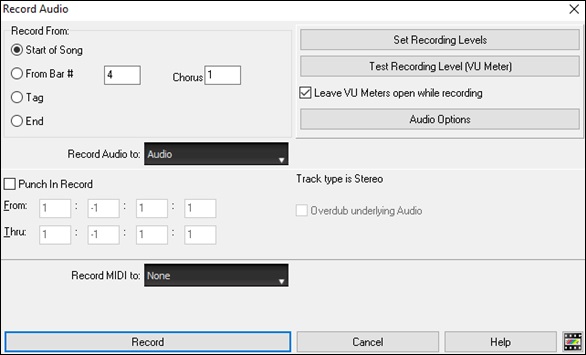
Set the start point for the recording.
You can record from the start of the song, somewhere in the middle, or punch in by choosing a bar and chorus # to start recording.
Select the destination track.
Audio can be recorded to the Audio or a Utility track.
Select the destination track for recording MIDI.
If you also want to record MIDI at the same time, choose the destination track with the “Record MIDI to” option.
Press [Record].
Audio recording begins. If you have enabled the “Leave VU Meter while recording” option, then the VU Meter will open and display during recording so you can monitor the VU meters.
Press the [Stop] toolbar button or press the [Esc] key.
You will then see the “Keep Take?” dialog.
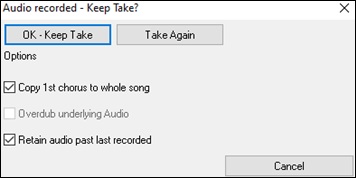
If you are happy with your recording, you should choose [OK -Keep Take] and the audio will be added to the Audio track.
You can listen to the results by pressing [Play].
If you are not happy with the results, you can choose Edit | Undo Keep Audio Take and you will be back to where you were prior to the recording. You can also choose the option to [Take Again], which reopens the Recording dialog.
Copy 1st chorus to whole song: If you’ve recorded only 1 chorus of the song, you can choose the option to copy that first chorus of audio to the whole song. This will fill up the whole song with the audio by repeating it as many times as necessary. Then you’d just need to record the ending of the song.
Overdub underlying audio: At the end of recording, you receive an option to overdub with the underlying audio. This means that both recordings will be merged together to form a new file, with both recordings preserved.
Retain audio past last recorded: This allows you to “punch out” and preserve the rest of a previously recorded take.
Opening and Importing Audio Files
A mono or stereo WAV file can be imported to the Audio track, optionally merging with or replacing any existing Audio track. Choose the menu item File | Import Audio (WAV, WMA, MP3, WMV) or Audio | Import Audio (WAV, WMA, MP3, WMV). You then choose an audio file to import. The Import Audio File dialog is then displayed, which allows selection of the the destination track, the point to insert the audio file, and whether to merge or overwrite existing audio in the destination.
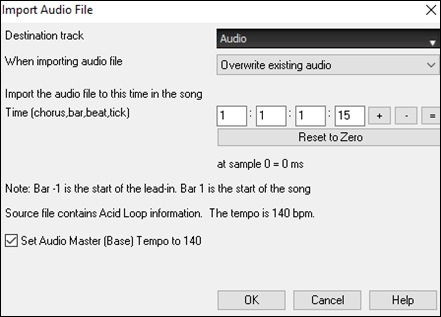
If the audio file contains Acid Loop or Apple® Loop information, the dialog shows an option to set the audio base tempo of the current song to the tempo of the audio file.
Adding Solo - “The Soloist”
That’s right! Band-in-a-Box can “solo like a pro” in hundreds of styles. You can either use the dedicated Soloist track or assign a soloist RealTrack to any track.
There are two ways to select and add a solo to your song. The “Best Soloist” feature presents a pre-qualified list of soloist to choose from. The Select Soloist dialog gives you the full list of soloists to choose from, plus additional settings you can apply to the solo.
Pick “Best” Soloist RealTracks
This dialog shows you the best soloists that match the genre, tempo, and feel of your song. The list is displayed from best to worst. For example, if you have a Jazz Ballad style loaded (tempo 60), the list will show jazz Soloists that will work well at a tempo of 60 at the top of the list, and something like a fast, Heavy Metal Guitar Soloist at the bottom of the list.
How to Use This Feature
To add a Best Soloist to the Soloist track, press the Soloist button, and choose the menu option “Add Best RealTracks Soloist to Soloist Track.”
![]()
To add a best Soloist to any track, right-click (or double-click) on the instrument radio button (e.g. Piano) and choose the Select RealTracks | Select Best Soloist RealTracks menu command.

You will then see the dialog that lists the best soloists for the current style.
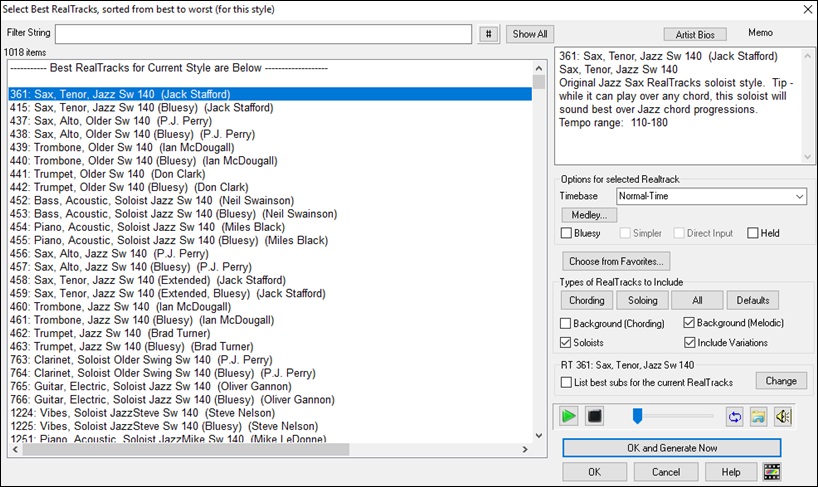
|
It will include “Soloists” and “Background (Melodic).” You can de-select these if you want to see only “Soloists” (and not “Background”). |
![]() You can audition the RealTracks by double-clicking on the list or using the transport control buttons.
You can audition the RealTracks by double-clicking on the list or using the transport control buttons.
|
You can choose options (timebase, bluesy, simple, etc.) for the selected RealTrack. |
|
Enabling the “List best subs for the current RealTracks” option will list RealTracks that are similar to the currently selected RealTracks. |
Pressing the [Artist Bios] button opens the Artist Browser which lists all RealDrums artists and allows you to see more info.
Select Soloist Dialog
Use the [Soloist] button on the main screen to open the Select Soloist dialog and choose from over 2000 Soloist profiles.

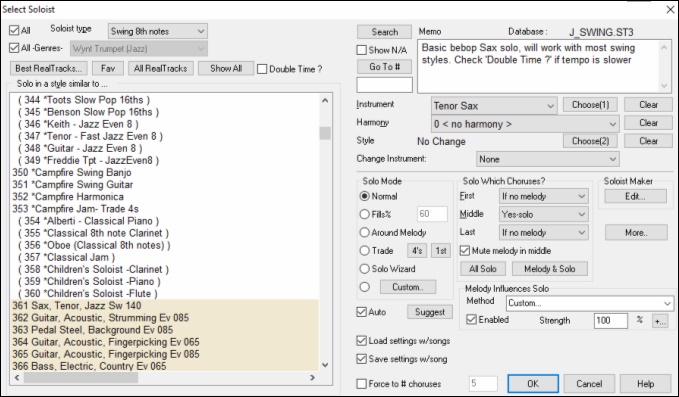
You can select a Soloist type (e.g. Modern Jazz) and see only soloists matching the type.
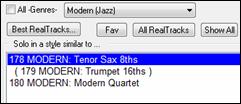
![]() And you can also filter to show/not show soloists from Soloist sets that you don’t have.
And you can also filter to show/not show soloists from Soloist sets that you don’t have.
Use the preset Soloist settings or choose a Mode and which Choruses to solo.
RealTracks Solos
Band-in-a-Box has RealTracks instruments, which are live audio recordings of studio musicians. These RealTracks replace the MIDI track for that instrument and can be controlled just like the MIDI instrument (volume changes, muting etc.). RealTracks can be can be generated to the Soloist (or Melody) track using the Soloist feature.
![]() There are hundreds of RealTracks soloists available, starting at #361 in the list of soloing styles.
There are hundreds of RealTracks soloists available, starting at #361 in the list of soloing styles.
![]() The [Best RealTracks] button gives you a list of the best RealTracks soloists for the current Band-in-a-Box style.
The [Best RealTracks] button gives you a list of the best RealTracks soloists for the current Band-in-a-Box style.
RealTracks solos are saved with the song, so you will hear the RealTracks play the same solo when you reload the song. When you generate a solo using RealTracks, Band-in-a-Box will remember this, and when you go to save the song, Band-in-a-Box will ask you if you want to save that solo (and thereby freeze the Soloist track). If you say yes, then the solo will play instantly the same way when the song is reloaded. Of course, you can freeze the soloist track yourself at any time. Note that only one solo can be saved. You can’t generate a bunch of different segments of solos; only the last one will be saved.
![]() With the “Trade” feature, you can Trade 2’s, Trade 4’s, or Trade 8’s between your live playing and the Soloist. Toggle between [1st] and [2nd] to choose who goes first, the soloist or you.
With the “Trade” feature, you can Trade 2’s, Trade 4’s, or Trade 8’s between your live playing and the Soloist. Toggle between [1st] and [2nd] to choose who goes first, the soloist or you.
There is a dedicated function to vary the start times of notes on the Melody or Soloist tracks, with options for what notes to affect (harmony, chords, and amount of variance). Choose menu item Soloist | Edit Soloist Track | Quantize, Time Adjust | Loosen Start Times.
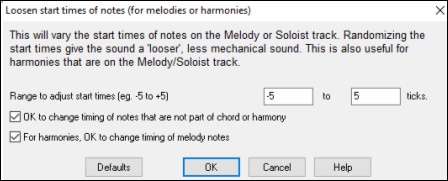
Using the Soloist Feature
- Generate a Soloist and practice the solo by looping it, slowing it down, or printing it out, until you can perform a great solo on any chord changes.
- Generate a Soloist and attach a Harmony such as “Big Band Brass” to create phenomenally quick and interesting Big Band Arrangements automatically. Generate a standard MIDI file or print them out (with PowerTracks Pro) for you and your friends.
- Have the Soloist play a solo according to your accompaniment and arrangement (along with the other members of your Band-in-a-Box, of course!)
- Trade 4’s in a call-response fashion with the Soloist (you solo for 4 bars, Band-in-a-Box solos for 4 bars, etc.).
- Concentrate separately on different aspects of your playing with assistance from the “Wizard” from soloing with proper phrasing and “feel” (the best notes are included automatically) to accompanying a soloist with confidence and authority. (Tip: try muting out one of the accompaniment parts such as the piano or guitar part and play along to the Soloist in a supportive role-- it’s fun!)< li>
- Use the Soloist track to record another part in addition to the Melody and other parts provided by Band-in-a-Box.
- Generate a Soloist on chords/keys that you would like to practice. Band-in-a-Box will play and solo with you all day without getting bored. For example, if you want to work on your II-V7-I progressions (“two-five-one”), you can just type the chords you want, and generate a solo to play over those changes. As the solo plays, you see the notation, can you can sight read along. Pressing the “Loop Screen” checkbox on the notation will loop the notation the screen so you can master each 4-bar phrase (II-V-I) and then move ahead to the next one!
|
The Soloist Maker [Edit] button gives access to the advanced settings in the Soloist Editor where you can edit existing profiles or create new Soloists of your own. |
|
To see the Soloist part play in the standard music notation, open the Notation window and click on the track selector button to select the Soloist track.s. |

Automatic Songs - “The Melodist”
Feel like composing a brand-new song? With Band-in-a-Box you can compose a new song, in the style of your choice complete with intro, chords, melody, arrangement, and improvisations, all created by the program! All you have to do is pick from one of the “Melodists” and press [OK] - the program then automatically generates the intro, chords, melody, and arrangement in the chosen style. It even auto-generates a title! You can go from nothing to a completed song in less than 1 second!
You can also auto-regenerate any part of a song and modify it to suit you. The Melodist will also generate a melody over an existing chord progression. A “Melodist Juke Box” mode creates and performs new compositions in succession.
To launch the Melodist, press the [Melodist] button on the main screen, or use the Shift+F5 hot keys. |
|
Melodists can be filtered by “Genre” (e.g. EZ listening) to show only Melodists in that genre. You can also filter to show/not show Melodists from Melodist sets that you don’t have. Check “Show if N/A” to list all Melodists, even if they are not included in your Band-in-a-Box. |

Song Editing Features
The on-screen display of the song file name includes “*” when the file has been changed.
![]()
Edit | Undo and Edit | Redo allow you to Undo (or redo) most operations. Multiple Undo supports up to 999 levels of undo (configurable).
The default number of undo is 99. If you need to change this, it can be done in Options | Preferences “Number of Levels of Undo.” The range can be 5 to 999. You can also choose Edit | Redo to redo an undo.
![]()
Edit | Cut functions like a delete command. It removes bars of chords from a song.
Copy/Move Tracks
The Copy/Move Tracks command in the Edit | Copy Special submenu allows copying or moving data (audio and/or MIDI) from one track to another.
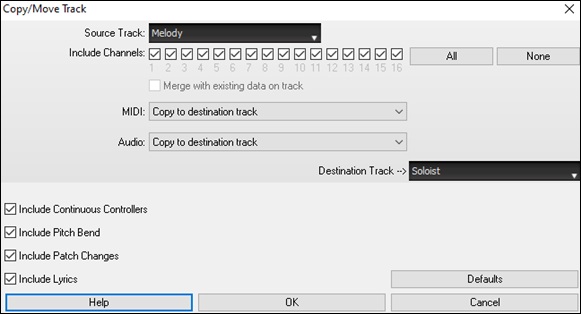
Select the Source Track that you want to copy or move data from and the Destination Track that will receive the copied or moved data. The source and destination tracks can be any track - Bass, Drums, Piano, Guitar, Strings, Melody, Soloist, Audio, or Utility.
You should also select the action (Do nothing, Copy, or Move) for each of MIDI and Audio.
When copying or moving MIDI data, if you enable the Merge with existing data on tack option, the MIDI data in the destination track will be preserved and merged with the incoming MIDI data from the source track. If this option is disabled, the MIDI data in the destination track will be replaced with the incoming MIDI data.
There are also options to include continuous controllers, pitch bend, patch changes, and lyrics when copying or moving MIDI data.
Examples of uses include:
- Loading a MIDI file to the Melody track, and copying the bass part to the Bass track, and then freezing the Bass track. This allows you to setup a MIDI file with the same tracks as Band-in-a-Box uses. Note: the command automatically freezes the destination track after the copy.
- Getting the RealChart to play, to double a RealTracks part on another instrument. To do this, generate a RealTracks for piano on the piano track. Then copy the piano track to the strings track and set a strings patch. You now hear a RealTracks piano, with the strings doubling the piano part.
- Replacing a RealChart with a MIDI version. If a RealChart is available, copy the RealChart as in the example above. Then eliminate the RealTracks on the original track. You now have a RealChart MIDI part playing instead of the RealTracks, and you can edit that part etc. as with any MIDI track.
Nudge Chords/Melody
The “Nudge” feature allows moving a range of chords by any number of bars/beats. For example, let’s say that you have entered a complete song chord progression, and you then realize that all of the chords starting at bar 23 are 1 beat too late (maybe due to a time signature change). You can move all of the chords 1 beat earlier, by setting the nudge at bar 23, beat 1, and duration of the nudge to -1 (minus 1) beats.
You can nudge chords and/or Melody/Soloist tracks.
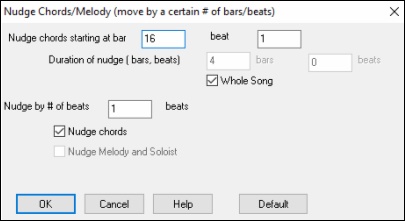
Unfold (Convert to 1 BIG chorus)
Choose Edit | Song Form | Unfold (convert to one BIG chorus) to unfold a multi-chorus song into one BIG chorus.
![]() becomes
becomes ![]()
If you have a song with 3 choruses and want to convert it to a single large chorus, this command unfolds the song into just that; one BIG chorus. This is useful for customizing a song with style, patch or tempo changes in different verses.
Fold (Convert 1 chorus to multiple)
A “Fold song” routine converts a song with a single large chorus to multiple smaller choruses with optional tag ending. If you have imported a MIDI file, you might have a file that is 96 bars long, but really consists of 3 choruses of 32 bars each. You can convert this to a 32-bar song by using the Edit | Song Form | Fold menu item, including inserting tag endings, and 2-bar endings.
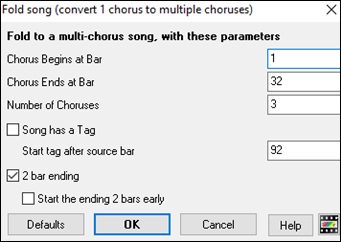
![]() becomes
becomes ![]()
Adding Repeats and 1st/2nd Endings
For this tutorial, we will be using demos from the “Tutorial - Repeats and Endings” folder. Load in the Song “Miles1 Tutorial (no repeats yet)” from the Tutorial – Repeats and Endings folder. You will see that this is a 1-32 bar form. There are no repeats and endings entered for this song. We will be adding them now. When you load in a song, you will notice some “Form Marker” features that happen for any Band-in-a-Box song.

![]()
![]()
![]()
Repeat symbols are drawn at the beginning and end of the entire form (bars 1, 32 in this song) and “end” is written on bar 33, which is the ending.
Bars past the end of the song are colored gray.
These form markers are present for every song, unless you disable them by Preferences | Display. These are not the type of repeats/endings we’re referring to here however. The repeats/endings we are talking about now occur during the form, and are the 1st/2nd endings, DS al Coda and other repeat types that you see on a typical lead sheet.
So, in our song “Miles1 Tutorial (no repeats yet),” we can have a look at it and see if there are any repeats/endings.
It appears from looking at the Chord Sheet that this 32-bar form consists of two 16 bar sections, with a 1st ending at bar 9, and a 2nd ending at bar 25.
So now we’d like Band-in-a-Box to display it like that, with the first and second ending markings.
Since we want to insert the 1st/2nd ending on bar 9, we right-click on the Chord Sheet on bar 9 and select Repeats/Codas/1st-2nd Endings.

We then see the Edit Repeats and Endings dialog.
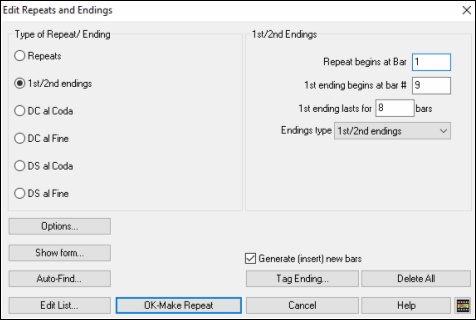
Click on the 1st/2nd endings radio button and enter the following.
- Repeat begins at bar 1.
- 1st ending begins at bar 9.
- 1st ending lasts for 8 bars.
- Type of Repeat/Ending = 1st/2nd endings.
By entering this data we’ve defined the complete 1st and 2nd ending. If the 1st ending begins at bar 9 and lasts for 8 bars, the 2nd ending must begin at bar 17+8=25 (there’s an 8-bar repeated section from bar 1 to 8).
Now, this was a pre-existing song, and it already has all of the bars laid out. So, we make sure that we don’t select the Generate (insert) new bars checkbox.
Click on [OK-Make Repeat], and the repeat gets made, and the Chord Sheet redraws with the 1st/2ndrepeat showing.
![]() Make sure you have Fake Sheet mode selected on the Chord Sheet.
Make sure you have Fake Sheet mode selected on the Chord Sheet.

As you can see there is a 1st ending at bar 9. At bar 16 there is a repeat symbol, indicating that the form goes back to bar 1 for 8 bars, and then will go to the bar after bar 16 for the 2nd ending. The 2nd ending is marked there. The bar # is 25, because the bars are numbered in linear fashion, and it is the 25th bar of the song as it would be played. Then the song goes to the end, which is bar 32.
![]() Now we can see a LINEAR view of the same song, similar to the way it was before we put the 1st/2nd endings on it. To do this, deselect the Fake Sheet checkbox on the main page. You will then see the song like this.
Now we can see a LINEAR view of the same song, similar to the way it was before we put the 1st/2nd endings on it. To do this, deselect the Fake Sheet checkbox on the main page. You will then see the song like this.
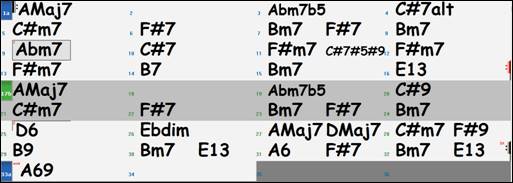
This shows all of the 32 bars, including the bars that are part of the repeat – these are highlighted in gray. Exposing these bars shows the linear view of the song, the way the song would be played. It also allows you to enter custom information for any of the bars, including the bars in the “gray area.” For example, if you wanted the chord at bar 21 to be an Em9 instead of an Em7, just type it in, even though it’s in the repeated section leading to the 2nd ending.
You can toggle between the 2 views for the traditional lead sheet view with the Fake Sheet mode, and the “normal” (linear) view with Fake Sheet mode OFF.
Buttons in the Edit Repeats and Endings dialog
The [Options] button opens s the Display Options dialog, which includes an option to globally enable/disable the display of repeats and endings.
The [Show form] button displays a summary of the form of the song as examined by Band-in-a-Box. This is useful for analyzing the form of the song, in case you want to add your own repeats and endings manually, and want a quick summary of the form. Band-in-a-Box shows you the form in 2-bar sections. A typical AABA song might display a form like this.
0, 1, 2, 3
0, 1, 2, 4
5, 6, 7, 8
0, 1, 2, 4
Each of these numbers represents a unique 2 bar section of the song. You can see the first section (0, 1, 2, 3) is similar to the second section (0, 1, 2, 4) in fact they differ only in the last 2 bars. So, this would be a good candidate for a 1st/2nd ending. Also, the last A section of 0, 1, 2, 4 is identical to the 2nd A section, so would be a good candidate for a DC al Coda symbol.
When you press the [Auto-Find] button, Band-in-a-Box will examine the song and try to detect any repeats in the song.
The [Edit List] button shows you a list of repeats or endings that have been entered in the song and allows you to edit them.
The [Tag Ending] button opens the Song Setting dialog where you can set a tag ending.
The [Delete All] button will delete all the repeats that have been entered in the current song.
Set Time Signature (for range of bars)
Under the Edit | Set Time Signature (range of bars) menu item, you can assign a specific time signature at any bar and apply it to a range of bars, as often as you want.

For example, to have one bar (bar 13) of 5/4, select Edit | Set Time Signature… and toggle the 5/4 button. Then, type in the bar beginning and ending range in the space provided. (In this case, 13 and 1.)
Transpose

The Edit | Transpose submenu lets you transpose the entire song by a number of semitones, or specify a range to transpose. To transpose part of a song, simply highlight the area you wish to transpose and select Transpose From.. To.. in the submenu.
|
When you have confirmed the starting bar and the number of bars you wish to transpose, click on the “Transpose to Key” area and select the destination key. |
Settings for Current Bar
The number of beats per bar, tempo changes, patch, style, and harmony changes can be made by selecting the Settings For Current Bar option on the Edit menu or by pressing F5 after you have selected a bar to edit.
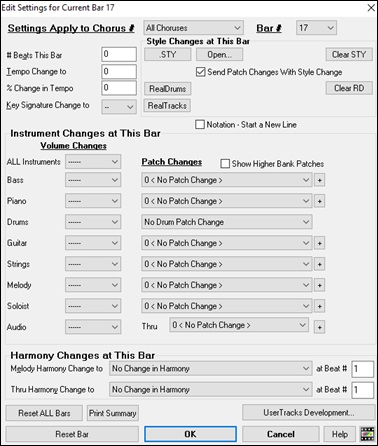
Settings Apply to Chorus # - You can specify the changes you make to happen for every chorus and/or a specific chorus. This applies to bar settings like tempo changes, style changes, RealDrums changes, patch changes, volume changes, and harmony changes.
Bar # - You can change the bar to edit without existing the dialog.
# of Beats this Bar - The initial time signature of the song is determined by the style (e.g., Jazz =4/4, Waltz =3/4). In some songs you will want to change the time signature, for example, you might want a single bar of 2/4, or 8 bars of 3/4 time. This option allows a change of time signature during a song. The change takes place at the beginning of the bar and continues until a new time signature change is specified. You can select from 1 to 4 beats per bar. Time signature changes are printed on the Notation/Lead Sheet.

Example: A song in 4/4 time with a single bar of 6/4 time
The maximum # beats per bar is =4, so we will split the 6/4 bar into 2 bars, a 4/4 bar and a 2/4 bar. Insert a # beats per bar =2 at the beginning of the 2/4 bar, then restore the time signature to 4/4 by assigning # beats per bar =4 for the next bar.
Tempo Change to - If you want to change the tempo at a certain bar of the song, then use this dialog to type in the new tempo in beats per minute. The tempo change takes effect at the beginning of the bar and remains until a new tempo change at another bar is inserted. Alternatively, you can specify a percentage change in tempo.
Key Signature Change to - You can have multiple keys in the same song with the new key signature shown on notation. Select the new key signature you want from the combo list and you will see the new key signature drawn on the notation at that bar.

Style Changes at This Bar - To choose a new style for this bar you can select the style from the StylePicker by pressing the [.STY] button or from the C:\bb\Styles folder by pressing [Open]. You can audition a style in the StylePicker without changing your existing arrangement, by using the Quick - play using premade demo area, which plays a streaming demo from the web. For example, if you see a style like _JSWINGG “Jazz Swing w/ Electric Guitar” you can hear what it sounds like without loading in the style. This is useful because you hear an audio demo of a good example of the style in action. It is also useful because it can demo a style that you don’t have, or you can compare to make sure that yours sounds the same as it is supposed to sound.
|
When chosen, the name of the style change for the current bar will be displayed. Click on the [Clear STY] button if you want no style change to occur. Individual styles have instrument patches assigned to them. Send Patch changes with style change allows the option to send those assigned patches at the current bar. If you would like to keep the patches that had been previously used in the song, deselect this option. |
RealDrums Changes at any Bar - You can have multiple RealDrums styles within a song. You can either enter a change of RealDrums, or enter a change of style, which will also result in a change of RealDrums. The name of the new RealDrums style is displayed. The [Clear RD] button deletes the RealDrums change.
RealTracks Changes at any Bar - You can insert a specific RealTracks instrument at any bar to create a customized performance. You can change specific RealTracks without changing the style. For example, if you want to change an Acoustic Bass comping part to an Acoustic Bass Solo at Chorus 4, Bar 1, you can do this. Press the [RealTracks] button and you will see the RealTracks Changes dialog where you can choose which tracks you would like to have RealTracks changes on. Select a track, press the ![]() button, and select a RealTracks from the list of available RealTracks.
button, and select a RealTracks from the list of available RealTracks.

Notation - Start a New Line - You can set the notation to start a new line at any bar. This allows you to customize the number of bars on each line and is used in conjunction with the Notation Options settings of bars-per-line on the notation. This feature works for chord sections.
Instrument Changes -
Volume and patch changes can be made for instrument parts and the Audio track at any bar.
Volume changes can be specified values or fade up/down amounts. There are presets to mute or restore the volume level for a part.
Patch selections include patches on higher banks, which are accessed with the [+] button.
Harmony Changes at This bar - You set a harmony to begin or end at this bar for the Melody or Soloist/Thru track. If you choose < no harmony >, a harmony that was previously playing will stop. Set a specific beat for the harmony to begin, for example on a lead-in or pickup note at the end of a bar. You can also switch to different harmonies in the middle of your song.
Style, tempo, key signature, volume, patch, and harmony changes will be recorded on your song worksheet indicated by a red line below the bar number. Changes remain in effect from that bar forward until new changes are recorded or until the next chorus if you have set the changes to apply only to the current chorus.
[Reset ALL Bars] will remove any settings you have changed for all bars.
[Reset Bar] will remove any settings you have changed for the current bar.
[UserTracks Development] will open a dialog for advanced settings when making UserTracks.
[Print Summary] will open a text report of all settings in the song that have been made in the dialog. This summary is also available from the Song Memo.
Song Memo
![]() A Song Memo of up to 2,000 characters may be added. Clicking on the [Memo] button launches the Song Memo dialog, where you can type or edit a memo about the song and select an “Auto-open” option that will show the memo each time the song is loaded.
A Song Memo of up to 2,000 characters may be added. Clicking on the [Memo] button launches the Song Memo dialog, where you can type or edit a memo about the song and select an “Auto-open” option that will show the memo each time the song is loaded.
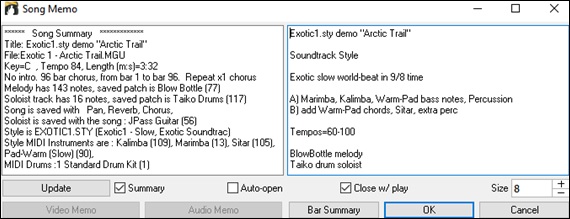
The dialog has an option to close automatically during playback. When thes Close w/ play option is set, the dialog will close when the song starts to playp and not reopen when it stops. This setting, in combination with the Auto-open setting, ensures that the memo opens when the song opens, but closes during playback. The font for the song memo is size selectable.
Type your memo in the right side of the dialog and press the [Update] button.
If the Summary checkbox is selected, the dialog displays a full summary of the song (title/tempo/patches used in the song), as well as other special features such as substyle patch changes or harmonies.
If the song contains a video or audio memo, you can play it with the [Video Memo] or [Audio Memo] button. You can add a video memo to your song by creating a video file (wmv, mp4, m4v) with the same name as your song file followed by _VideoMemo. For example, for mysong.mgu, save a video memo as mysong_VideoMemo.wmv. Similarly, you can add an audio memo to your song by creating an audio file (wma, mp3, wav) with the same name as your song file followed by _AudioMemo.
Press the [Bar Summary] button to see a report of any changes to settings that are programmed in the Edit Bar Settings dialog (F5).
View and Print Notation
|
Open the Notation window with the [Notation] toolbar button. You will see standard notation on the grand staff. There are 3 notation modes in Band-in-a-Box, selected with the buttons in the Notation window toolbar. |
![]() Standard Notation for display of notes, chords, lyrics, and optional guitar tablature as well as entering chords and lyrics. Notation is not editable in this mode.
Standard Notation for display of notes, chords, lyrics, and optional guitar tablature as well as entering chords and lyrics. Notation is not editable in this mode.

![]() Click this button to go to Editable Notation mode. Chords, lyrics, and text can be entered as in the Standard Notation mode; the Editable Notation mode also permits point-and-click entry of notes and rests as well as drag-and-drop editing.
Click this button to go to Editable Notation mode. Chords, lyrics, and text can be entered as in the Standard Notation mode; the Editable Notation mode also permits point-and-click entry of notes and rests as well as drag-and-drop editing.

![]() Click this button to go to Editable Notation mode. Chords, lyrics, and text can be entered as in the Standard Notation mode; the Editable Notation mode also permits point-and-click entry of notes and rests as well as drag-and-drop editing.
Click this button to go to Editable Notation mode. Chords, lyrics, and text can be entered as in the Standard Notation mode; the Editable Notation mode also permits point-and-click entry of notes and rests as well as drag-and-drop editing.
Lead Sheet Window
The Lead Sheet Notation window displays a full page of notation with lots of options such as a selectable number of staves per page, clefs to show, font size, margins, scroll-ahead notation, and lyrics. You can set it to a big font size and read the notation from across the room. Since the notation scrolls ahead, you can read ahead without waiting for a page turn.
|
You can launch the Lead Sheet window from the main screen by pressing the [Lead Sheet] button (or Alt+W). |
![]() The Lead Sheet window is also accessible from the Standard Notation window.
The Lead Sheet window is also accessible from the Standard Notation window.
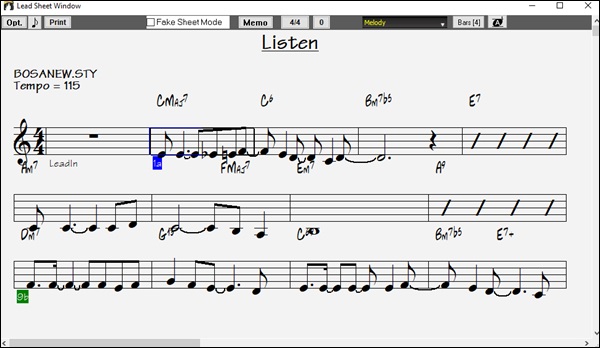
Multiple Tracks of Notation
Multiple tracks of notation can be viewed together in the Lead Sheet window. To add tracks to display, click on the [+] button to the right of the track selector button, and select the tracks in the order that they should appear from top to bottom. Multiple tracks can also be printed like a score.
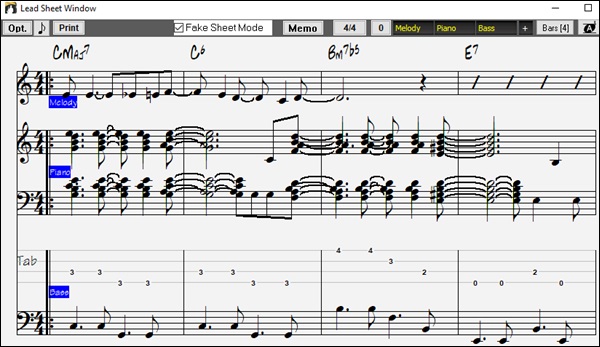
Printing
![]() Click on the [Print] button in either the Notation window or the Lead Sheet window to print your song as sheet music. This launches the [Print Options] dialog with a full range of options including “Number of Copies” to print and “Print Range.” The options are fully described in the online Help and in the Notation chapter of this manual.
Click on the [Print] button in either the Notation window or the Lead Sheet window to print your song as sheet music. This launches the [Print Options] dialog with a full range of options including “Number of Copies” to print and “Print Range.” The options are fully described in the online Help and in the Notation chapter of this manual.
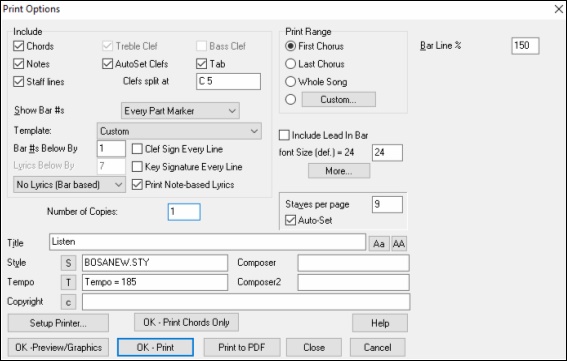
The Medley Maker
Would you like Band-in-a-Box to make a medley of various Band-in-a-Box songs (MGU)? This is easily done with the Medley Maker. Inside the Medley Maker, simply select the songs that you want, and Band-in-a-Box will make the medley for you.
|
To open the Medley Maker, click on the [Song Form] menu button on the Tools toolbar and select Medley Maker in the menu, or choose File | Import | Medley Maker. |
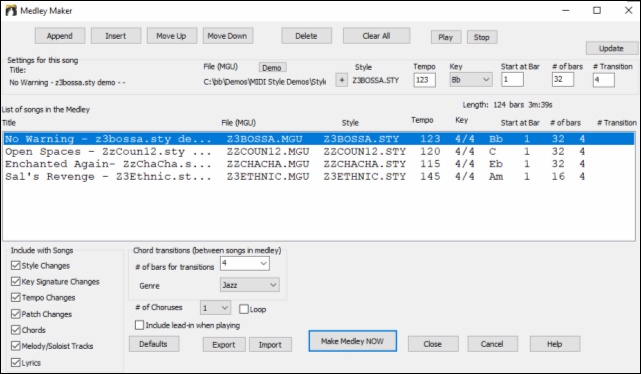
A medley is not simply joining songs together. A good medley uses a “transition” area between songs to introduce the new style, key, and tempo. The Medley Maker automatically creates a nice transition area for you, writing in chords that would smoothly modulate to the next song, style, key, and tempo!
To make a medley,
- add songs by pressing the [Append] or [Insert] button.
- remove songs using [Delete].
- change the order of the songs using [Move Up], [Move Down].
- for any song, customize using the “Settings for this song” group box, including changing the style, tempo, key, start bar, # of bars, and # of transition bars. Press [Update] after customizing to see your changes in the medley list.
- choose the type of information to include with your medley (styles, key signature changes, lyrics, etc.) in the “Include with Songs” group box
- choose a number of transition bars (the default is 4). Transition bars are automatic bars of chords inserted by Band-in-a-Box to transition from one song to the other, generating an “outro” and an “intro” between songs.
Press the [Make Medley NOW] button to generate a medley.
The maximum size of the medley is 255 bars (about 7 minutes).
![]() The current size and time of your medley is displayed in the Length label.
The current size and time of your medley is displayed in the Length label.
![]() You can have multiple choruses, so if you had 3 choruses of a 250-bar medley, it would last 750 bars.
You can have multiple choruses, so if you had 3 choruses of a 250-bar medley, it would last 750 bars.
Saving Songs
|
Once you have made a song (or have made changes to a song), you will probably want to save the song by clicking on the [Save] button. Or choose Save from the File menu, or press F2, or Ctrl+S. |
|
Use [Save As] to save a song with a different name or in a different location. (Songs that are “Saved As” with a different name have the new name added to the Recently Played song dialog.) The [Save As] button menu includes additional options for saving a song. |
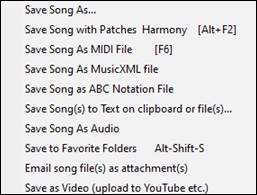
Save Song with Patches & Harmony (Alt+F2) allows you to save a song with custom patch selections plus volume, reverb, bank, harmony, soloist and RealDrums. You can also choose to freeze tracks when saved. See the following topic, Saving Song Settings.
Songs will always be saved with last file extension letter of “U,” regardless of whether they are made with a built-in style or not. For example, if you make a song with ZZJAZZ.STY as the style (one of the 24 built-in styles), early versions of BB would save the song as MySong.MG1, where the “1” indicates Style #1 – ZZJAZZ. Now it is saved as MySong.MGU. Older songs loaded in with .MG1 will still be re-saved as MG1 to prevent duplicate song files.
If you have an audio file associated with the song, the audio portion will be saved separately, and will be called MySong.WAV.
Saving Song Settings
By default, all settings are saved with songs unless the “Save all Settings with Songs” box is unchecked (off) in the Assign Instruments and Harmonies to Song dialog (Alt+F2 or File | Save Special | Save Song with Patches & Harmony).
![]()
This includes RealTracks, RealDrums, and RealTracks solos as well as Patches, Volume, Audio and MIDI Reverb, Tone, Panning, Bank, Harmony (both Melody and Thru), and the Soloist.
If you have some custom items that you don’t want to save with the song, you can uncheck the “Save all Settings” box and use this dialog to save only the settings you want to keep.
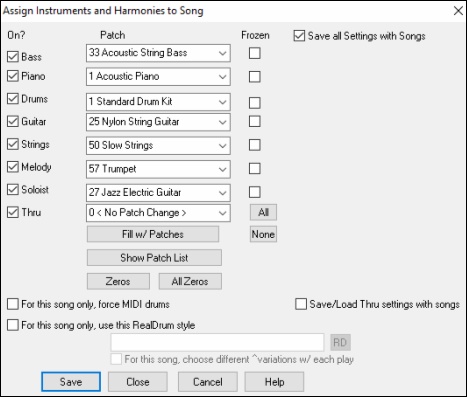
To save certain patches with a song:
- Choose the patch (instrument) that you would like from the dropdown patch list. Leave the other instruments at = 0 for no patch change. Remember that the General MIDI numbering system is always used for instruments.
or
- Press the [Fill w/Patches] button. This will fill the patch number boxes with the current patch settings showing on your main screen instrument panel.
Use the checkboxes to choose which instruments you would like to save and whether you would like to save the Melody and Thru harmony assignments and the Soloist selected to play on the song. You can also save the instruments as “On” or “Off” for each song. For example, you could have a song with no piano part.
Use the “Frozen” checkbox to put the track into a frozen state where it gets saved with the specific arrangement and won’t be overwritten by Band-in-a-Box.
You can still edit the frozen tracks.
Select the “For this song only, force MIDI drums” checkbox if you always want MIDI drums, not RealDrums, used with the song.
Select “For this song only, use this RealDrum style” to assign a specific RealDrums style to your song. Press the [RD] button to choose the RealDrums style.
This dialog is usually used in combination with and not instead of saving a song. To save a song with this embedded information to your hard drive, you therefore:
Choose File | Save Special | Save with Patches and Harmony (Alt+F2).
Choose the patch and other settings that you want to embed.
Press the [Save] button to save the song to disk.
Note that if you have set a MIDI patch for one of the instrument parts (bass/drums/piano/guitar/strings) and you load in another style, Band-in-a-Box will overwrite your patches with the style patches. If it didn’t do that, you would be stuck with the same patches regardless of the style. So, if you want a certain patch for a track, set it after you have loaded in the style that you want.
Saving Frozen Tracks
Any track can be frozen (MIDI or RealTrack). When frozen, it won’t get changed or re-generated. This saves time when replaying previous songs and allows you to freeze an arrangement that you like. If you freeze the whole song, you don’t have to wait at all for the song to regenerate. Next time you play, it is ready to go.
All tracks can be edited and saved. MIDI tracks for bass, drums, piano, guitar and strings can be edited, and saved with the file. If you freeze a track, edits can be still made to it, because it is only frozen from Band-in-a-Box making changes to it (you can still edit it), so that the MIDI track will be saved to the file. So, you can customize the bass track to match a certain song, and save it with a frozen bass track, so that Band-in-a-Box won’t overwrite your edits. This includes RealCharts – if you wanted to edit the notation of a RealTracks solo for example.
To edit a MIDI track (bass, drums, piano, guitar, strings), or the MIDI part of a RealTracks that has a RealChart (MIDI transcribed solo), simply open the Notation window or Piano Roll window and click on the track and edit it. Make sure to Freeze the track by pressing the [Freeze] button and choosing Freeze for that track, or right-clicking on the instrument at the top of the screen and choosing Freeze. Now your edited tracks will save with the song.
Email Song as Attachments
You can email a song (.MGU or .SGU), style (.STY and .STX) or rendered audio file (m4a, wma, wav, or mp3) as attachments.
|
Press the [Save As] button and choose Email song file(s) as attachment(s) to open the Email Song dialog. |

The dialog allows you to choose what files you want to email:
- the song (.MGU or .SGU)
- the style (.STY and .STX)
- a rendered audio file (choice of m4a, wma, wav, mp3)
Saving as Video and Upload to YouTube
You can save your song as a video that you can upload to YouTube or work with in video programs. You can make a video for the Chord Sheet or the Notation window that shows the highlighted chords or notes moving as the song plays.
|
To use this feature, press the [Save as] button and choose Save as Video from the pulldown menu. |
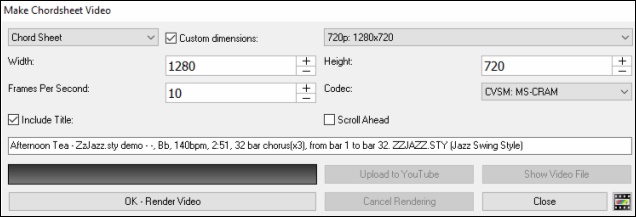
At the top left corner, choose the item (Chord Sheet or Notation track) to include in a video.
Enable Custom dimension if you want to choose the width and height of the video. If this is disabled, the video dimensions will match the Chord Sheet as it appears.
A higher number you set for Frames Per Second will result in a large file and the rendering process will take longer.
You can select a specific Codec to encode the video. If “Auto” is selected, Band-in-a-Box will choose a compatible codec.
If Include Title is enabled, the video of the Chord Sheet will have a black bar at the top containing the title shown below.
The Scroll Ahead option makes video of the Chord Sheet scroll so the bar that is currently playing will always be at the top of the video (i.e., more bars ahead will be visible).
Click on the [OK - Render Video] button to start rendering the video. The video will continue to render unless you press the [Cancel Rendering] button. When the rendering is done, a message will show and you will be able to press the [Upload to YouTube] or [Show Video File].
Saving Song as MusicXML
Band-in-a-Box supports MusicXML so you can easily export your Band-in-a-Box songs into notation programs such as Finale, Sibelius, and Guitar Pro, while retaining the chords from the Band-in-a-Box song.
|
To save the song as a MusicXML file, press the [Save As] button and select Save Song as MusicXML file or go to menu File | Save Special | Save Song as MusicXML file. |
When BB File Save dialog opens, specify a file name and the location, and press the [Save] button. This will open the Save XML File dialog.
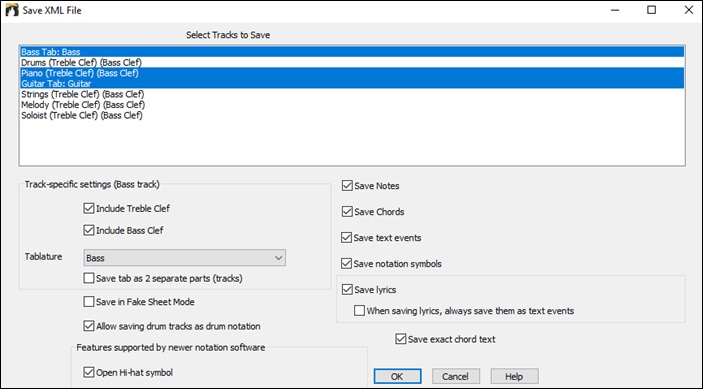
First, select a track that you want to save in the XML file. To select multiple tracks, Ctrl+click on the track.
Then, select elements that you want to save in the XML file.
The Track-specific settings area lets you choose which clef to include for each track.
There is also an option to include a Tablature.
The Save tab as 2 separate parts (tracks) option will save two parts: one for a notation track and the other for a tablature.
If you enable the Save in Fake Sheet Mode option, repeated sections will be hidden.
The Save exact chord text option allows you to save the exact chord text, rather than relying mainly on saving the chord type and degrees.
Press [OK], and the file will be ready to be opened in your notation program.
Saving Song as ABC Notation File
ABC notation is the simple text-based notation system used by musicians worldwide to store chords, melody, and lyrics of songs. You can find out more information about the songs and ABC notation at abcnotation.com.
|
To save the song as an ABC Notation file, press the [Save As] button and select Save as ABC Notation file or go to menu File | Save Special | Save Song as ABC Notation file. |
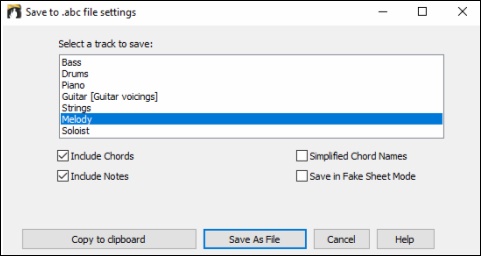
Select a track to save: Click on the track that you want to save in the file. This applies if “Include Notes” is enabled.
Include Chords: Check this to save chords in the file.
Include Notes: When this option is checked, notes on the selected track will be saved.
Simplified Chord Name: When this is enabled, complicated chords will be written as simplified names. For example, D7#5#9 will be written as D7.
Save in Fake Sheet mode: Enable the fake sheet mode if you want to save repeats and endings in the file.
[Copy to clipboard]: Pressing this button will copy the file to the clipboard. You can then paste it into other programs.
[Save as File]: Press this button, and then you type a name and select the destination in your hard drive.
Saving Song(s) as Simple Text
You can save the song, including the chords and other information (title, key, tempo, form, style, etc.), as a text file.
|
Press the [Save As] button and select Save Song(s) to Text on clipboard or file(s), or go to menu File | Save Special | Save Song(s) to Text on clipboard or file(s). This will open the Song(s) to Text dialog. |
In the dialog, check the items you want to include in text. By default, the song metadata (title, key, tempo, form, style, etc.) and memo will be included, but if you don’t want them, you can exclude them. Select the Whole Song mode, and press the [Save as .txt file] button. If you want to copy the song to the clipboard instead of saving it as a text file, press the [OK - Copy to Clipboard] button instead.
The dialog also has an option to copy or save all songs in a specific folder. Select the Batch save all songs in this folder mode, press the folder icon to select the folder, and choose the option to include subfolders of that folder. Also select the destination with the Batch Save As option. You can copy all songs to the clipboard, save them as individual text files in the same folder, save them as individual text files in another folder, or save them as a single text file. Then, press [OK -Batch Save TXT] to copy or save the song.

Saving MIDI and Karaoke Files
|
Your Band-in-a-Box songs can be saved as Type 0 and Type 1 MIDI files as well as Karaoke files and General MIDI lyrics. Click on the [.MID] button or press [F6] key to launch the dialog. |
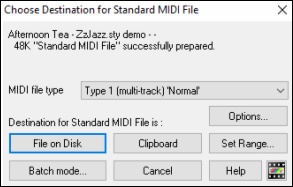
Select the type of MIDI file you want to save in the dropdown “MIDI File type” combo box.

By default, Band-in-a-Box writes Type 1 multiple track Standard MIDI Files. You can also save Type 0 MIDI files, they have all of the parts on a single track and are used by many hardware modules and other devices that play MIDI files because they are simpler to play (since they only have 1 track).
Karaoke files (.KAR) are a special type of sing-along MIDI file with text events for the lyrics and a specific order for the tracks. There is an option to write the MIDI file with separate tracks for each drum instrument. In the “MIDI File type” combo box, select “Drums on separate tracks.”
MIDI File Options
![]() Use this button to set custom MIDI file settings in the MIDI file options dialog. This dialog is also available from the [MIDI File] button in the Preferences dialog (Options | Preferences).
Use this button to set custom MIDI file settings in the MIDI file options dialog. This dialog is also available from the [MIDI File] button in the Preferences dialog (Options | Preferences).
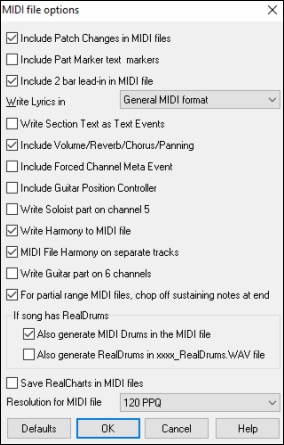
Include Patch Changes in MIDI files will include the patch (instrument) changes.
Include Part Marker text markers writes descriptive text part markers to the MIDI file if selected. If “Include Part Marker text markers” is selected the resulting MIDI file will have text markers. Then, in PowerTracks Pro Audio or RealBand (in the Bars window) you will see the descriptive text markers. For example, at bar 3, there is an “A, Chorus 1” marker, to indicate a part marker “a” substyle and chorus 1. Text markers are also read in from MIDI files and displayed as Section Markers on the Notation.
Include 2 bar lead-in in MIDI file: If you don’t want to create a MIDI file containing the first 2 bars of the 1—2—1-2-3-4 count-in you can select this option. If there is a Melody pickup, then the 2-bar lead-in will remain in the file.
Write Lyrics in General MIDI format: The GM specification has agreed upon specific requirements for writing lyrics in MIDI files, which are supported, so that lyrics that you save in Band-in-a-Box should show up identically in other MIDI programs. This is one of the MIDI File options in the Preferences dialog. We recommend the GM format.
Write Section Text as Text Events: Your section text can be included in the MIDI file as text events.
Include Volume/Reverb/Chorus/Panning: This will include the volume, reverb, chorus, and panning settings that you have made in the Band-in-a-Box synth window in your MIDI file.
Include Forced Channel Meta Event: This will include the forced channel META event. It is recognized by PowerTracks Pro Audio and other PG Music Inc. programs only.
Include Guitar Position Controller: This will insert a controller 84 which PG Music uses to indicate the fret position. Since some synths also use this for Portamento Control, you should use this setting with caution.
Write Soloist Part On Channel 5: ormally the program writes the Soloist part on channel 8. Since that could also mean the left hand of a piano track using the convention of channel 8/9 for piano, this option allows you to write it on channel 5 instead.
Write Harmony To MIDI File: If set to YES, the harmony will be written to the MIDI file. If not, just the melody will be written to the MIDI file.
MIDI File Harmony on separate tracks If set to YES, the harmony will be written to the MIDI file on separate tracks for each voice. You could use this to print out individual parts to your printer for example.
Write Guitar part on 6 channels: If set to YES, the styles that are Intelligent Guitar Styles will result in a MIDI file that has the Guitar part written on 6 channels (11-16). Then, when you read it in PowerTracks, or another sequencer that uses the convention of 11-16 for guitar strings, the guitar part will display correctly.
For partial range MIDI files, chop off sustaining notes at end turns off notes that would be “hung” because their associated Note Off event does not fall within the range of bars saved to the MIDI file.
If song has RealDrums, Also generate MIDI Drums in the MIDI file can be unchecked if your song uses RealDrums and you don’t want MIDI drums included in the MIDI file.
If song has RealDrums, Also generate RealDrums in xxxx_RealDrums.WAV file saves the RealDrums (which are audio) as a separate wave file. This allows you to easily import the entire Band-in-a-Box song into another program for editing.
Set range of bars for MIDI files
![]() When making a MIDI file, you can select a range of bars to be included. Highlight any range of bars, and the MIDI file will be made for just that range.
When making a MIDI file, you can select a range of bars to be included. Highlight any range of bars, and the MIDI file will be made for just that range.
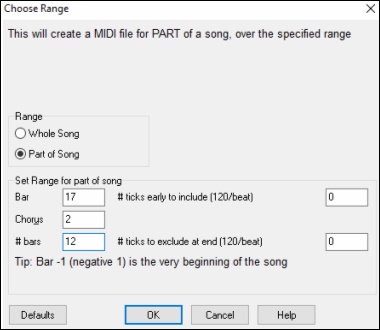
For example, you could select Chorus #2 if that is the chorus that you want.
The resultant MIDI file will be made from the selected range.
![]() Alternatively, without selecting a range on the Chord Sheet, you can make a MIDI file for a partial range by pressing the MIDI file button, and then the “Set Range” button.
Alternatively, without selecting a range on the Chord Sheet, you can make a MIDI file for a partial range by pressing the MIDI file button, and then the “Set Range” button.
Batch convert a folder of songs to MIDI files
You can convert an entire folder of Band-in-a-Box songs to MIDI files with a single command and choose the resultant file names to be based on either the file name or the song title name.
![]() Press the [Batch mode] button in the MIDI file dialog to access this feature.
Press the [Batch mode] button in the MIDI file dialog to access this feature.
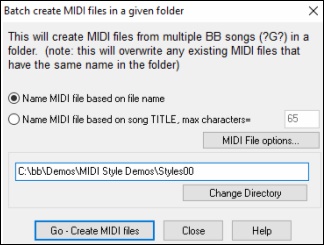
Save Options
![]() [File on Disk] saves a MIDI file to your hard drive or floppy disk. You can then load the MIDI file into your sequencer for further editing.
[File on Disk] saves a MIDI file to your hard drive or floppy disk. You can then load the MIDI file into your sequencer for further editing.
![]() [Clipboard] copies the MIDI file to the Windows® clipboard as a standard MIDI file. This feature allows clipboard enabled programs to Edit | Paste the Band-in-a-Box MIDI file directly into the program. For example, you can clipboard-paste Band-in-a-Box MIDI data to PowerTracks Pro Audio, CakeWalk, Musicator, etc.
[Clipboard] copies the MIDI file to the Windows® clipboard as a standard MIDI file. This feature allows clipboard enabled programs to Edit | Paste the Band-in-a-Box MIDI file directly into the program. For example, you can clipboard-paste Band-in-a-Box MIDI data to PowerTracks Pro Audio, CakeWalk, Musicator, etc.
The Melody/Soloist (with harmonies) will be written to the MIDI file. If you’ve set a Melody or Soloist/Thru Harmony, that MIDI data will be written to the MIDI file also. See the settings in the Options | Preferences dialog to control how the harmony is written to a MIDI file.
The Chord Sheet part markers are written to the MIDI files. They can be read by PowerTracks Pro Audio and by Band-in-a-Box if re-importing the MIDI file with the Chord Wizard.
Recording to External Hardware Sequencers
Many people use Band-in-a-Box in live situations. If you are unable to bring your computer with you, a good alternative is a hardware sequencer or a keyboard with a built-in sequencer that reads Standard MIDI Files. To transfer songs to the Sound Brush, follow these simple steps:
- Make a MIDI file of the song by pressing the button.
- Either save the file directly to a floppy disk or copy it to the floppy from your hard drive.
- The Sound Brush is then able to read the IBM formatted disk with MIDI files on it.
MGX Files
When a MIDI file is loaded onto the Melody (or Soloist) track, the Track Type for the Melody (or Soloist) gets set to Multi-Track. When the file is saved, the extension will be MGX, allowing you to easily identify the Band-in-a-Box songs that you have that contain entire MIDI files.
Saving Audio Files
If you have recorded an acoustic instrument, Band-in-a-Box can render the MIDI data to an audio file and merge it with your live audio recording to produce a complete digital audio file.
|
Press the [.WAV] button and choose Export Song as Audio File from the menu. This will open the Render to Audio File dialog. |
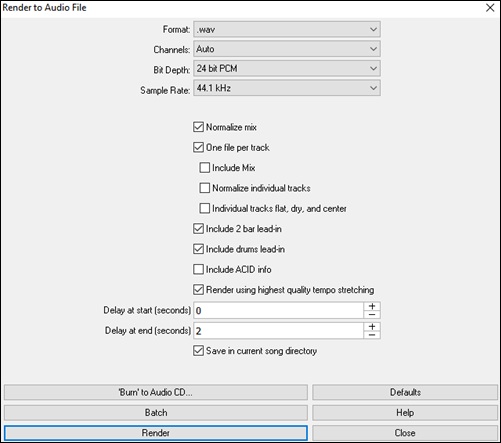
Format: Select the format of the audio file: WAV, WMA, WMA (lossless), M4A, or MP3. Note: If you are using Windows® XP or Vista, the M4A option requires Apple® QuickTime® Library for Windows®, available from www.apple.com.
Channels: When “Auto” is selected, individual tracks will be rendered as either mono or stereo, depending on the original source. You can also force to render all tracks as stereo or mono.
Bit Depth: Select 16, 24, or 32 bit. (The default is 24 bit.)
Sample Rate: Select 44.1, 48, or 96 kHz. (The default is 44.1 kHz.)
Quality: The bit rate selection is available for compressed audio files (WMA, M4A, and MP3).
Normalize mix: Enable this option if you want the audio file normalized. Normalizing boosts the volume to a maximum level without distortion, but it takes longer to render.
One file per track: If this option is enabled, you will get separate audio files, one for each track.
Include Mix: If this is enabled, a mix of all tracks will be rendered to a separate file.
Normalize individual tracks: Enable this option if you want each track normalized individually. This applies if the “One file per track” option is enabled or when you drag and drop an individual track out of Band-in-a-Box.
Individual tracks flat, dry, and center: If this option is enabled, each track will render ignoring its Mixer settings (Volume, Pan, Reverb, and Tone), and the default settings will be used instead. The default settings are Volume=0 dB, Pan = 0, Reverb= 0, Tone = 0. If this option is disabled and there is no lead-in in the Melody track, the lead-in will be skipped in the rendered file.
Include 2 bar lead-in: If this option is disabled and there is no lead-in in the Melody track, the lead-in will be skipped in the rendered file.
Include drums lead-in: Enable this if you want to include the drum count-in the rendered file.
Include ACID info: If you are rendering to a WAV audio file, you can include ACID information such as tempo, key, and time signature. The ACID information can be read by many DAW programs.
Render using highest quality tempo stretching: If this option is enabled, the highest quality tempo stretching setting for élastique will be used when rendering. You may be using a lower quality setting for playback in order to increase performance, but this is not necessary when rendering to an audio file.
Delay at start (seconds): This allows you to add silence in seconds at the start of the audio file.
Delay at end (seconds): You can also add silence in seconds at the end of the audio file.
Save in current song: If the option is checked, the Save dialog will default to the current song file’s directory. Otherwise, it will default to the previously used directory.
[Burn to Audio CD]: This button will open the MiniBurn program, which allows you to burn your own CD.
[Batch]: This button allows you to render all songs in a folder to audio files.
[Render]: To render the song, press this button and select the name and destination for the audio file.
Batch convert a folder of songs to audio files (MP3, WAV, or WMA)
Do you need to convert an entire folder of Band-in-a-Box songs to audio files? This can be done easily by a single command with an option to name the resultant audio files based either on the original file name or the song title name.
Press the [Batch] button in the Render to Audio File dialog to open the Batch create audio files dialog.
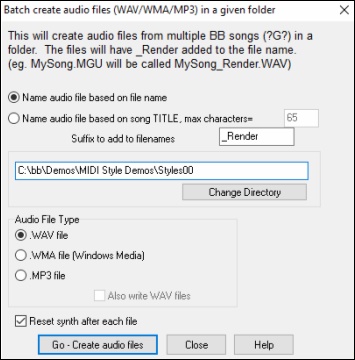
Select the folder that you want to use (e.g. C:\bb\my songs).

Add a suffix for each file name.
![]() For example, if the suffix is _Demo, then MySong.MGU will render as MySong_Demo.WAV.
For example, if the suffix is _Demo, then MySong.MGU will render as MySong_Demo.WAV.
Choose whether you want the filenames to be based on the filename or the song title.
![]()
|
Select the file type for the output file from the “Audio File Type” group box. When rendering to WMA or MP3 files, there is an option to also write WAV files. |
![]() This option resets the VSTi/DXi synth after each render. This ensures that no audio (stuck notes etc.) from previous file is retained.
This option resets the VSTi/DXi synth after each render. This ensures that no audio (stuck notes etc.) from previous file is retained.
![]() Press the [Go - Create audio files] button to render all of the Band-in-a-Box files in the folder to the selected audio format.
Press the [Go - Create audio files] button to render all of the Band-in-a-Box files in the folder to the selected audio format.
![]() There is a Cancel button in the Batch Rendering dialog.
There is a Cancel button in the Batch Rendering dialog.
Burn your own Audio-CD
Press the [Burn to Audio CD] button in the Render to Audio File dialog to launch the MiniBurn program and burn your wave file to a CD, which will then play in a standard CD player.
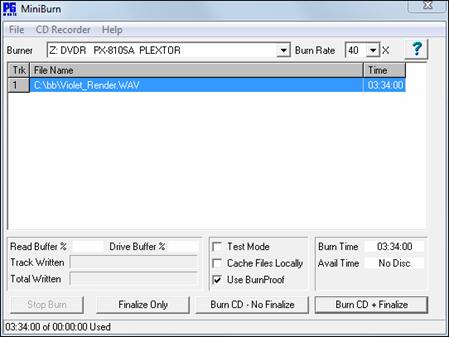
If launched from Band-in-a-Box, the current BIAB song has automatically been added to the Burn List. If MiniBurn is running standalone, you must add Wave files to the Burn List.
Burn List
Burn list files are displayed in MiniBurn’s central file list region.
Column 1- Track Number
Column 2- Path and name of Wave files
Column 3- Play time of each Track, formatted in minutes:seconds:frames
Burn Time indicates the sum of all the burn list track times.
Avail Time indicates the time available on the blank CD-R in the CD Burner. If no disc has been inserted, Avail Time reads “No Disc.” If an unwriteable disc has been inserted (CD-ROM disc or already-finalized CD-R, CD-RW), Avail Time reads “UnWritable.”
Add Files to the Burn List
Wave files can be added three ways:
- Use the menu item File/Add Track…
- Right-click on the Burn List and select “Add Track” from the pop-up menu.
- Drag wave files into the MiniBurn window from an open Windows® folder view.
Remove Files from the Burn List
Files can be removed two ways:
- Left-click to select a track, then use the menu item File | Remove Selected Track.
- Left-click to select a track, then right-click on the Burn List and pick “Remove Track” from the pop-up menu.
Clear All Files from the Burn List
The list can be cleared two ways:
- Use the menu item File | Clear All Tracks from Burn List.
- Right-click on the Burn List and select “Clear All Tracks” from the pop-up menu.
Change the Order of Tracks in the Burn List
Left-click on the “Trk” column of the file you wish to move and drag the file to a new location in the list.
Audition Tracks in the Burn List
Left-click to select a track in the Burn List, then right-click and pick “Play Selected File” from the pop-up menu.
To stop playback, right-click the Burn List and pick “Stop” from the pop-up menu.
It is not necessary to stop a wave file before playing a new wave file. It is not necessary to stop playback before burning. Playback stops automatically before burning begins.
Burner Controls
Eject: Open the drive tray using the menu item CD Recorder | Eject. Of course, you can also press the eject button on the CD drive.
Close the Drive Tray: Close the drive tray using the menu item CD Recorder | Close Tray. You can also press the eject button on the CD drive, or gently push the drive tray to close it. Some manufacturers advise against closing the tray with a push.
Select a Burner
If the computer contains multiple burners, select a drive with the Burner drop-down menu. If a computer doesn’t have any supported drives, the Burner menu will be empty and burning is not possible.
Set the Burn Rate
MiniBurn automatically selects the fastest rate reported by your drive. It is typical to use the fastest rate, unless you know from previous experience that your computer doesn’t burn well at high speed. In that case, set a slower burn rate to ensure a good burn.
Test Mode Checkbox (Simulate Burn)
To test the CD Burner without actually writing a CD, turn on the Test Mode checkbox. After your PC has “proven itself” with a couple of good burns, routine testing is not necessary.
Cache Files Checkbox
If Cache Files is turned ON, MiniBurn writes an encoded temporary file before burning the CD. Unless burn errors are encountered, performance is faster with this option turned OFF. It is not usually necessary to Cache Files, but there are some situations where Caching is helpful:
1. On a very slow PC, the computer may not be fast enough to translate the wave file to CD audio while burning. Caching may be necessary to avoid errors.
2. If Burn List audio files are stored in another PC on your local network, the network transfer delay may cause errors. Caching will pre-fetch the files to your local hard disk before burning the CD.
Use Burn Proof Checkbox
Burn Proof is a technology available on many newer CD/DVD burners. With Burn Proof, it is less likely to accidentally make a bad CD. If a burner has the Burn Proof feature, the checkbox is automatically enabled and turned ON. If a burner does not have this feature, the checkbox is grayed-out and cannot be adjusted. Unless Burn Proof seems to be causing unlikely strange problems, always use this feature if it is available.
Burn CD + Finalize (Make Playable CD)
Start CD burning. This button is the preferred way to make CDs for use with standalone Audio CD Players. With the other options, “Burn CD – No Finalize” and “Finalize Only,” the tracks will typically be readable by computer CDROM drives, but all of your recorded tracks may not be visible to standalone Audio CD Players, even after the disc is finalized.
Burn CD – No Finalize (allow tracks to be added later)
Audio CDs must be “finalized” before they can be recognized by the majority of stand-alone audio CD players (stereos, boom boxes, portable CD players, automobile CD Players), or television DVD players. However, many computer CD drives can play “Un-Finalized” audio CDs, so you can play them on your computer until all the songs have been added to the CD.
Use “Burn CD – No Finalize” if you wish to add tracks to an audio CD over more than one session.
When adding tracks to an “Un-Finalized” audio CD, the Available Time field displays the “empty” time remaining on the CDR (the disc currently loaded in your burner).
Example: If you have already recorded 40 minutes to a 74- minute CDR, MiniBurn will display about 34 minutes of Available Time. Take care not to add more tracks than will properly fit on the CD’s remaining empty space.
Make sure that the Total Time does not exceed the Available Time!
Finalize Only (Make Playable CD without adding new tracks)
Audio CDs must be “Finalized” before they can be recognized by the majority of stand-alone audio CD players (stereos, boom boxes, portable CD players, automobile CD Players), or television DVD players. If you have previously added tracks to a disc with the Burn CD – No Finalize function, you can finalize the disc with the Finalize Only button.
Stop Burn
Stop burning before the disc is finished.
Note: If you prematurely Stop, the CD will almost certainly be ruined.
Burning Progress
While a CD is burning, progress is indicated in the lower-left of the MiniBurn window. Progress messages are also displayed in the Status Bar at the bottom of the window.
Read Buffer %- The computer’s disk read buffer usage. If Burn Proof is not available, you may have burn errors if this drops to zero in mid-burn. In this case, try a slower Burn Rate.
Drive Buffer %- The CD Burner’s write buffer usage. If Burn Proof is not available, you may have burn errors if this ever drops to zero. In this case, try a slower Burn Rate.
If a bona-fide buffer under-run actually occurs, MiniBurn also displays an error dialog at the end of the burn.
The two Buffer fields are most useful for diagnosing problems-- If the Read Buffer gets too low, it may mean that the Hard Drive (or network connection) is not fast enough.
If the Drive Buffer gets too low but the Read Buffer remains adequate, it may mean that background processes are stealing too much CPU time from MiniBurn.
Track Written- Indicate the current track’s progress.
Total Written- Indicate the progress of the entire burn.
Save Track as Performance
This feature takes “freezing” a track one step further and saves the audio itself. So, you can send your Band-in-a-Box song to your friend, who will be able to play that track without needing to have the RealTracks installed.
To save the track, right-click on the track radio button and go to Track Actions | Save Track as Performance File. You have a choice of a WAV file or a WMA file. When you choose, the track will be rendered to C:\bb\<Song Title><track name>(e.g. Bass).WAV or .WMA.
![]()
![]()
You can use the Erase Performance Track command to remove the Performance Track.
![]()
![]()
![]()
For example, if the song is MySong.mgu, you put a file named MySong Melody.wma in the same folder, and that will be a performance track on the Melody track.
Saving your Configuration
|
The [Prefs] button opens the Preferences dialog, which allows you to set the program settings that are saved in the Band-in-a-Box configuration file called intrface.bbw. The various Preferences are described in detail in the Reference chapter. |
Custom Preferences
You can save and load custom preferences files with your current settings saved and restored. For example, you can have a preference that remembers a certain group of songs, notation transpositions, etc.
The Options | Return to Factory Settings menu command saves preferences to disk, so that the settings can be restored at any time.
Choose the menu item Options | Save Preferences As to save a configuration or Options | Open Preferences File to load a saved configuration.

Congratulations!
You have been through the full process of song production in Band-in-a-Box.
You can now produce a complete song in Band-in-a-Box with a melody, solo, and harmonies plus RealDrums and RealTracks and your own audio track with harmonies and professional effects.
You can print out beautiful notation in a professional “handwritten” Jazz font, complete with chord symbols, lyrics and your own text markers and annotations. And you can save your song in various MIDI and audio formats for playback from your computer, over the Internet, or from an audio CD.
You are ready for endless hours of fun and great music with Band-in-a-Box.
Unconditional 30-Day Money Back Guarantee on all PG Music products purchased from PG Music Inc.
PG Music Inc.
29 Cadillac Ave Victoria BC Canada V8Z 1T3
Sales: 800-268-6272, 250-475-2874,+ 800-4746-8742*
* Outside USA & Canada where International Freephone service is available.
Access Codes
Tech Support: Live Chat, support@pgmusic.com
 Online now
Online now
Need Help?
Customer Sales & Support
|
Phones (Pacific Time) 1-800-268-6272 1-250-475-2874 |
||
| Live Chat | ||
| OPEN | Online Ordering 24/7 |
|
| OPEN | Forums, email, web support |

